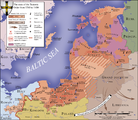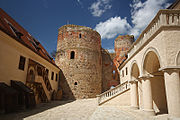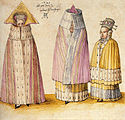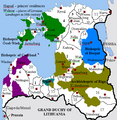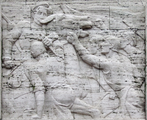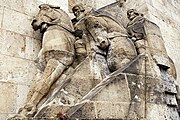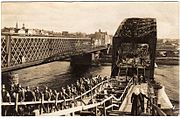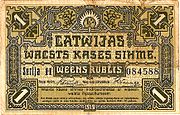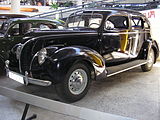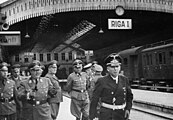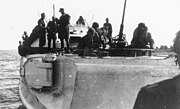Szerkesztő:Hollófernyiges/próbalap
| Conocephalus | ||||||||||||||||||||
|---|---|---|---|---|---|---|---|---|---|---|---|---|---|---|---|---|---|---|---|---|
 Kis kúpfejűszöcske
| ||||||||||||||||||||
| Rendszertani besorolás | ||||||||||||||||||||
| ||||||||||||||||||||
| Hivatkozások | ||||||||||||||||||||
A Wikimédia Commons tartalmaz Conocephalus témájú kategóriát. |
A Conocephalus a fürgeszöcskefélék családjának egyik neme, amelyet a svéd Carl Peter Thunberg írt le 1815-ben.[1]
Jellemzőik[szerkesztés]
A Conocephalus (jelentése kúpfej) nem tagjai kis méretű szöcskék, hosszuk a fejtől a szárnyvégig 10-27 mm között mozog. Testalkatuk karcsú, fejük elülső része zöld és a nőstény hosszú tojócsöve általában egyenes.[2] Fedőszárnyaik hossza változó, egyes fajoknál mindig rövid, másoknál csak egyes egyedeknél fordul elő hosszú, a potrohvégen túlérő szárny, más fajoknál pedig minden egyed hosszú szárnyú.[3]
A fajok egyik jó határozóbélyege a hímek cerkuszának (potrohfüggelékének), illetve a nőstények tojócsövének alakja.[3]
Többnyire réteken, legelőkön, tisztásokon élnek, levelekkel, virágokkal, virágporral, de esetenként kis rovarokkal is táplálkoznak. A nőstények a lágyszárú növények szárába rakják petéiket.[2]
Fajok[szerkesztés]
A nembe az alábbi fajok tartoznak (alnemekre osztva):[4]
Conocephalus (Amurocephalus)[szerkesztés]
- subgenus: Storozhenko, 2004 (China)
- Conocephalus chinensis (Redtenbacher, 1891)
Conocephalus (Anisoptera)[szerkesztés]
- subgenus: Latreille, 1829 (Worldwide) - synonym Xiphidium Burmeister, 1838 Sablon:Div col
- Conocephalus aberrans (Redtenbacher, 1891)
- Conocephalus adustus (Redtenbacher, 1891)
- Conocephalus aigialus Rehn & Hebard, 1915
- Conocephalus algerinorum Massa, 1999
- Conocephalus angustifrons (Redtenbacher, 1891)
- Conocephalus angustivertex Pitkin, 1980
- Conocephalus armatipes (Karsch, 1893)
- Conocephalus attenuatus (Scudder, 1869)
- Conocephalus bakeri (Karny, 1920)
- Conocephalus bechuanensis (Péringuey, 1916)
- Conocephalus beybienkoi Storozhenko, 1981
- Conocephalus bidentatus Shi & Zheng, 1994
- Conocephalus bilineatus (Erichson, 1842)
- Conocephalus bivittatus (Bolívar, 1900)
- Conocephalus borellii (Giglio-Tos, 1897)
- Conocephalus borneensis (Redtenbacher, 1891)
- Conocephalus brevicercus (Karsch, 1893)
- Conocephalus brevipennis (Scudder, 1862)
- Conocephalus caudalis (Walker, 1869)
- Conocephalus chavesi (Bolívar, 1905)
- Conocephalus cinereus Thunberg, 1815
- Conocephalus cognatus (Redtenbacher, 1891)
- Conocephalus concolor (Burmeister, 1838)
- Conocephalus decaspinosus Nagar & Swaminathan, 2016
- Conocephalus denticercus (Karny, 1907)
- Conocephalus dorsalidentatus Li, Zhang & Shi, 2019
- Conocephalus dorsalis (Latreille, 1804)
- Conocephalus ebneri Harz, 1966
- Conocephalus equatorialis (Giglio-Tos, 1898)
- Conocephalus exemptus (Walker, 1869)
- Conocephalus exitiosus (McNeill, 1901)
- Conocephalus exsul (Karny, 1911)
- Conocephalus fasciatus (De Geer, 1773)
- Conocephalus flavus (Redtenbacher, 1891)
- Conocephalus formosus (Redtenbacher, 1891)
- Conocephalus fulmeki (Ebner, 1927)
- Conocephalus fuscus (Fabricius, 1793): disputed synonym C. discolor (Thunberg, 1815) - long-winged Conehead
- Conocephalus gigantius (Matsumura & Shiraki, 1908)
- Conocephalus goianus Piza, 1977
- Conocephalus gracilicercus Li & Shi, 2018
- Conocephalus gracillimus Morse, 1901
- Conocephalus guangdongensis Shi & Liang, 1997
- Conocephalus hainanensis Shi & Wang, 2015
- Conocephalus hastatus (Charpentier, 1825)
- Conocephalus hilli Farooqi & Usmani, 2019
- Conocephalus honorei (Bolívar, 1900)
- Conocephalus hygrophilus Rehn & Hebard, 1915
- Conocephalus ictus (Scudder, 1875)
- Conocephalus inconspicuus (Karny, 1920)
- Conocephalus infumatus (Redtenbacher, 1891)
- Conocephalus insularis (Morse, 1905)
- Conocephalus iriodes Rehn & Hebard, 1915
- Conocephalus iris (Serville, 1838)
- Conocephalus japonicus (Redtenbacher, 1891)
- Conocephalus kisi Harz, 1967
- Conocephalus kwasiphaiensis Nagar & Swaminathan, 2016
- Conocephalus liangi Liu & Zhang, 2007
- Conocephalus liebermanni Ebner, 1953
- Conocephalus longipennis (Haan, 1843)
- Conocephalus maculatus (Le Guillou, 1841)
- Conocephalus magdalenae Naskrecki, 2000
- Conocephalus meadowsae Harz, 1970
- Conocephalus melaenus (Haan, 1843)
- Conocephalus nanlingensis Li, Xin & Shi, 2019
- Conocephalus nemoralis (Scudder, 1875)
- Conocephalus nigropleuroides Fox, 1912
- Conocephalus nigropleurum (Bruner, 1891)
- Conocephalus occidentalis (Morse, 1901)
- Conocephalus oceanicus (Le Guillou, 1841)
- Conocephalus ochrotelus Rehn & Hebard, 1915
- Conocephalus percaudatus Bey-Bienko, 1955
- Conocephalus peringueyi Uvarov, 1928
- Conocephalus pictus (Redtenbacher, 1891)
- Conocephalus recticaudus Bruner, 1915
- Conocephalus redtenbacheri (Bolívar, 1905)
- Conocephalus rentzi Farooqi & Usmani, 2018
- Conocephalus resacensis Rehn & Hebard, 1915
- Conocephalus resinus (Saussure & Pictet, 1898)
- Conocephalus rhodesianus (Péringuey, 1916)
- Conocephalus saltator (Saussure, 1859)
- Conocephalus semivittatus (Walker, 1869)
- Conocephalus semraensis Farooqi & Usmani, 2021
- Conocephalus shanghaiensis Zhou, Bi & Liu, 2010
- Conocephalus signatus (Redtenbacher, 1891)
- Conocephalus spartinae (Fox, 1912)
- Conocephalus spinosus (Morse, 1901)
- Conocephalus starmuehlneri Kaltenbach, 1968
- Conocephalus strictus (Scudder, 1875)
- Conocephalus trifasciatus (Redtenbacher, 1891)
- Conocephalus trivittatus (Stål, 1861)
- Conocephalus truncatus (Redtenbacher, 1891)
- Conocephalus tumidus Pitkin, 1980
- Conocephalus tumultuosus Willemse, 1942
- Conocephalus unicolor Bruner, 1915
- Conocephalus versicolor (Redtenbacher, 1891)
- Conocephalus vestitus (Redtenbacher, 1891)
- Conocephalus willemsei Pitkin, 1980
- Conocephalus yunnanensis Shi & Feng, 2009
Conocephalus (Aphauropus)[szerkesztés]
- subgenus: Rehn & Hebard, 1915 (central America)
- Conocephalus leptopterus Rehn & Hebard, 1915
Conocephalus (Chloroxiphidion)[szerkesztés]
- subgenus: Hebard, 1922 (Africa, Australasia: probably incomplete)
- Conocephalus albescens (Walker, 1869)
- Conocephalus bituberculatus (Redtenbacher, 1891)
- Conocephalus dubius Willemse, 1942
- Conocephalus javanicus (Redtenbacher, 1891)
- Conocephalus laetus (Redtenbacher, 1891)
- Conocephalus striata Willemse, 1942
- Conocephalus upoluensis (Karny, 1907)
- Conocephalus vaginatus Willemse, 1942
Conocephalus (Conocephalus)[szerkesztés]
- subgenus: Thunberg, 1815 (Worldwide) Sablon:Div col
- Conocephalus bambusanus Ingrisch, 1990 (synonym C. abispinatus Hsia & Liu, 1990)
- Conocephalus basutoanus Chopard, 1955
- Conocephalus bispinatus Pitkin, 1980
- Conocephalus brevivalvus (Shi, Wang & Fu, 2005)
- Conocephalus brincki Chopard, 1955
- Conocephalus conocephalus (Linnaeus, 1767)
type species (as Gryllus conocephalus L.) - Conocephalus differentus Shi & Liang, 1997
- Conocephalus emeiensis Shi & Zheng, 1999
- Conocephalus lugubris (Redtenbacher, 1891)
- Conocephalus obtectus Karny, 1907
- Conocephalus saltans (Scudder, 1872)
- Conocephalus somali (Burr, 1900)
- Conocephalus sulcifrontis Xia & Liu, 1992
- Conocephalus tridens Hebard, 1933
- Conocephalus xiai Liu & Zhang, 2007
Conocephalus (Dicellurina)[szerkesztés]
- subgenus: Rehn & Hebard, 1938 (eastern USA)
- Conocephalus allardi (Caudell, 1910)
Conocephalus (Megalotheca)[szerkesztés]
- subgenus: Karny, 1907 (southern Africa, Madagascar)
- Conocephalus longiceps (Péringuey, 1916)
- Conocephalus marcelloi Gorochov & Llorente del Moral, 2004
- Conocephalus montana (Uvarov, 1928)
- Conocephalus namibius Gorochov, 2009
- Conocephalus nigrifrons (Chopard, 1952)
- Conocephalus parvula (Péringuey, 1916)
- Conocephalus phasma Gorochov & Llorente del Moral, 2004
- Conocephalus vaginalis (Karny, 1907)
- Conocephalus xiphidioides (Karny, 1907)
- Conocephalus zlobini Gorochov, 2009
Conocephalus (Opeastylus)[szerkesztés]
- subgenus: Rehn & Hebard, 1915 (southern America)
- Conocephalus longipes (Redtenbacher, 1891)
- Conocephalus vitticollis (Blanchard, 1851)
Conocephalus (Perissacanthus)[szerkesztés]
- subgenus: Rehn & Hebard, 1915 (Paraguay)
- Conocephalus strictoides (Caudell, 1906)
subgenus not assigned[szerkesztés]
- Conocephalus aculeatus Piza, 1969
- Conocephalus affinis Redtenbacher, 1891
- Conocephalus goianus Piza, 1977
- Conocephalus algerinorum Massa, 1999
- Conocephalus cinereus Thunberg, 1815
- Conocephalus differentus Shi & Liang, 1997
- Conocephalus emeiensis Shi & Zheng, 1999
- Conocephalus halophilus Ishikawa, 2004
- Conocephalus melaenoides Sänger & Helfert, 1995
- Conocephalus sojolensis Sänger & Helfert, 1995
- Conocephalus spinosus (Morse, 1901)
- Conocephalus stictomerus Rehn & Hebard, 1915
References[szerkesztés]
- ↑ Thunberg CP (1815) Mem. Acad. Imp. Sci. St. Peterburg 5:214, 218, 271.
- ↑ a b Genus Conocephalus - Lesser Meadow Katydids. bugguide.net . (Hozzáférés: 2023. március 8.)
- ↑ a b Genus Conocephalus (lesser meadow katydids). sina.orthsoc.org . (Hozzáférés: 2023. március 8.)
- ↑ Orthoptera Species File: Conocephalus Thunberg, 1815 (Version 5.0/5.0; retrieved 11 June 2021)
External links[szerkesztés]

The history of Latvia began around 9000 BC with the end of the last glacial period in northern Europe. Ancient Baltic peoples arrived in the area during the second millennium BC, and four distinct tribal realms in Latvia's territory were identifiable towards the end of the first millennium AD. Latvia's principal river Daugava, was at the head of an important trade route from the Baltic region through Russia into southern Europe and the Middle East that was used by the Vikings and later Nordic and German traders.
In the early medieval period, the region's peoples resisted Christianisation and became subject to attack through the Livonian Crusade. Latvia's capital city Riga, founded in 1201 by Germans at the mouth of the Daugava, became a strategic base in a papally-sanctioned conquest of the area by the Livonian Brothers of the Sword. It was to be the first major city of the southern Baltic and, after 1282, a principal trading centre in the Hanseatic League.
By the 16th century, Baltic German dominance in Terra Mariana was increasingly challenged by other powers. Because of Latvia's strategic location and prosperous trading city of Riga, its territories were a frequent focal point for conflict and conquest between at least four major powers: the State of the Teutonic Order, the Polish–Lithuanian Commonwealth, Sweden and the Russian Empire. The last period of external hegemony began in 1710, when control over Riga and parts of modern-day Latvia switched from Sweden to Russia during the Great Northern War. Under Russian control, Latvia was in the vanguard of industrialisation and the abolition of serfdom, so that by the end of the 19th century, it had become one of the most developed parts of the Russian Empire. The increasing social problems and rising discontent that this brought meant that Riga also played a leading role in the 1905 Russian Revolution.
The First Latvian National Awakening began in the 1850s and continued to bear fruit after World War I when, after two years of struggle in the Latvian War of Independence, Latvia finally won sovereign independence, as recognised by Soviet Russia in 1920 and by the international community in 1921. The Constitution of Latvia was adopted in 1922. Political instability and effects of the Great Depression led to the May 15, 1934 coup d'état by Prime Minister Kārlis Ulmanis. Latvia's independence was interrupted in June–July 1940, when the country was occupied and incorporated into the Soviet Union. In 1941 it was invaded and occupied by Nazi Germany, then reconquered by the Soviets in 1944–45.
From the mid-1940s Latvian Soviet Socialist Republic was subject to Soviet economic control and saw considerable Russification of its peoples. However, Latvian culture and infrastructures survived and, during the period of Soviet liberalisation under Mikhail Gorbachev, Latvia once again took a path towards independence, eventually succeeding in August 1991 to be recognised by Russia the following month. Since then, under restored independence, Latvia has become a member of the United Nations, entered NATO and joined the European Union.
Latvia's economy suffered greatly during the Great Recession which caused the 2008 Latvian financial crisis. Worsening economic conditions and better job opportunities in Western Europe have caused a massive Latvian emigration.[1]
Őstörténet[szerkesztés]




A mai Lettország területén a jégkorszak 14-12 ezer éve ért véget. Nem sokkal ezt követően, 11-12 ezer éve érkeztek meg az első vadászok, akik a rénszarvasok csordáit követték a folyók mentén és a Balti-jégtó partján, amely ekkor még jóval keletebbre húzódott, mint a mai tengerpart. A legkorábbi ismert kőszerszámokat Salaspils mellett találták; ezek őskőkoriak (kb. 12 ezer évesek) és a swideri kultúra készítette őket.
A középső kőkorszakban (i. e. 9000–5400) a vadászok-gyűjtögetők állandó településeket létesítettek. Táboraikat folyók és tavak mellett állították fel, például a Lubāns tó környékén 25 ilyen telepet tártak fel. Lakóik a kundai kultúrához tartoztak, szerszámaikat és fegyvereiket kőből, agancsból, csontból, fából készítették.[2]
Az újkőkor (i. e. 5000–1800)[szerkesztés]
A neolitikus kor beköszöntével (i. e. 5400–4100) megkezdődött a cserépedények készítése, az álattartás és a növénytermesztés.
A középső neolitikum során (i. e. 4100–2900) ebben a régióban alakult ki a narvai kultúra. Ekkor balti finnek éltek itt, a mai észtekkel és finnekkel rokon lívek előfutárai. A narvai a nagyobb területen elterjedt fésűdíszes kerámia kultúrjának volt a része.
Az újkőkor végén (2900–1800 BC) a zsinegdíszes kultúrához tartozó baltiak telepedtek meg a mai Lettország területén. A mai lettek az ő leszármazottaik.[3]
Vaskor (i. e. 500–i. sz. 1200)[szerkesztés]

A kora vaskortól (i. e. 500-i. sz 1.) elterjedtek a vasból készült szerszámok, és a hatékonyabb eszközökkel nagyobb termést tudtak elérni a mezőgazdaságban. A bronz (amelyből főleg dísztárgyakat készítettek) Lettországba külső kereskedelem révén került be, mert a régió szűkölködik mind réz-, mind ónércben.[2]
A középső vaskorban (i. sz 400–800) megkezdődött a balti és finn törzsek nagyobb szövetségekbe való tömörülése, a nagyobb területeket elfoglaló népek kialakulása. Létrejöttek a balti kurok, zemgalok, latgalok és szélek, valamint a finn lívek, észtek, vendek. A középkor elején Lettország fontos kereskedelmi útvonalak metszéspontjában feküdt. A vikingek a Daugava folyón felhajózva haladtak tovább Kijev, onnan pedig Konstantinápoly felé. Ezenkívül itt, a Balti-tenger partján voltak a borostyán legfontosabb lelőhelyei. A balti borostyán Görögországba és a Római Birodalomba is eljutott, sokhelyütt az aranynál is értékesebbnek számított. Az északot déllel összekötő borostyánút nem csak a féldrágakő, hanem más áruk, technológiák, eszmék is eljutottak egyik néptől a másikig.
650 körül a mai Grobiņa mellett a Vendel-korból származó skandinávok (valószínűleg gotlandiak) telepedtek meg a lett tengerparton és kb. 850-ig fennálló néhány száz fős települést hoztak létre. A baltiak sokrétű kapcsolatban álltak a skandinávokkal, a kurok pl. ekkoriban adót fizettek a svédországi királyoknak.
A vaskor végén (800–1200) elterjedt a háromnyomásos gazdálkodás, a rozstermesztés; a fazekaskorong és a fejlettebb fémfeldolgozási technikák jobb minőségű eszközök készítéséet tették lehetővé. A kereskedelemmel arab, nyugat-európai, angolszász pénzérémék kerültek Lettországba. A törzsek közötti háborúskodást és a külső fosztogatók jelenlétét jelzi a számos, fatörzsekből épített erődítmény.[4]
Korai államalakulatok[szerkesztés]
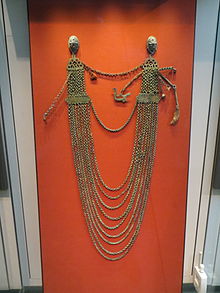
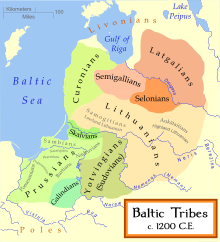

A 10. században a balti törzsek kezdetleges államokat kezdtek létrehozni. A mai Lettország és Észak-Litvánia területén helyi törzsi kultúrák formálódtak: a kurok, latgalok, szélek, zengalok, valamint a finnugor lívek. Közülük a latgaloké volt a legkiterjedtebb és társdalmi-politikai szempontból a legfejlettebb is. Legnagyobb fejedelmeségüket, Jerszikát a Rurikovics-házból való latgal-polacki ortodox keresztény fejedelmek irányították. Utolsó uralkodóját Livóniai Henrik krónikája szerint Visvaldisnak (Vissewalde, rex de Gercike) hívták. Ő 1211-ben felosztotta országát, melynek egyik részét Lettiának (terra, quae Lettia dicitur) hívták; feltehetően ez Lettország nevének első írásbeli megjelenítése.
Eközben a tengerpart mentén élő kurok a halászat és mezőgazdaság mellett kalózkodással, fosztogatással igyekeztek gazdagságot szerezni. A Balti-tenger nyugati partjain őket nevezték a "balti vikingeknek". A szélek és zemgalok (a későbbi felföldi Aukštaitija-beliek és zsemajtok közeli rokonai) mezőgazdaságból éltek. Az olyan vezetőikkel, mint Viestards ők álltal legtovább ellen a német befolyásnak. A lívek (róluk kapta a régió a Livónia nevet) a Rigai-öböl környékén halásztak és kereskedtek. Becslések szerint a 12. század végén - a német hódítás kezdete előtt - mintegy 135 ezer balti és 20 ezer lív élhetett Lettországban.
German period, 1184–1561[szerkesztés]
A 12. század végére Lettországot egyre gyakrabban látogatták nyugat-európai kereskedők, akik a Daugaván felhajózva akartak elérni a Kijevi Ruszba. Jelentős részük német volt és a kereskedőkkel papok is érkeztek, akik megkezdték a pogány baltiak és finnek keresztény hitre térítését.
Az 1180-as évek elején Szent Meinhard próbálta téríteni a Daugava környékén lakó líveket, akik azonban nem akartak felhagyni pogány szokásaikkal. Ezért aztán III. Cölesztin pápa 1195-ben meghirdette a livóniai keresztes hadjáratot, hogy erővel tegyék kereszténnyé őket. Meinhardot Hannoveri Berthold követte, akit a lívek a mai Riga közelében 1198-ban megöltek.
Berthold utóda, Albert rigai püspök majd 30 éven keresztül hajtotta uralma alá a helyi törzsfőket és megalapozta azt a német hegemóniát, amely egészen a függetlenség 20. száazdi kivívásáig kitartott. Tevékenysége Livóniai Henrik krónikájában olvasható. Bár Riga helyén az ősidők óta állt egy kereskedőállomás, a város megalapítását Albertnek tulajdonítják, aki 1201-ben itt állította fel székhelyét. Rigából fokozatosan a Balti-tenger déli partvidékének legnagyobb városa lett.
A pogányok elleni harc cáljaira 1202-ben megalakult a Livóniai Kardtestvérek egyházi lobagrendje. 1207-re uralmuk alá hajtották a líveket, 1214-re pedig a latgalokat is. 1207-ben az addig meghódított területeken megalapították Terra Mariana (Mária országa) államát, amely eleinte a Német-római birodalom hercegsége volt, 1215-ben pedig közvetlenül a pápa felügyelete alá került.
Az 1236-os saulei csatában a Kardtestvérek súlyos vereséget szenvedtek a baltiaktól, elesett a nagymester és lovagjaik megtizedelődtek. Ezért kérték összevonásukat a Teuton lovagrenddel, amelynek Livóniai Rend néven egyik ágazatává váltak. Az északi Livóniát és a teutonok déli Poroszországát azonban széles, pogány fennhatóság alatti területek választották el. A lovagok egyik fő célkitűzésévé vált összekötni területeiket, ezt azonban az 1260-as katasztrofális durbei csata után fel kellett adniuk.
A 13. század végére a kurokat és a zemgalokat is meghódoltatták; 1290 körül a zemgalok többsége a német fennhatóságú területekről átköltözött Litvániába. A törzsi államok kora lejárt, Lettország közvetlen német uralom alá került.
1282-ben Riga (később pedig Cēsis, Limbaži, Koknese és Valmiera is) bekerült az északnémet kereskedelmi ligába, a Hanza-szövetségbe. A város fontos csomóponttá vált a Kelet-és Nyugat-Európa közötti kereskedelemben, erős kulturális kötelékeket épített ki a Nyugattal.
A rigai püspök és a Livóniai Rend közötti konfliktus 1297-ben belháborúvá fajult, amely egészen 1330-ig tartott.
A helybeliek sokáig megtarthatták szabadságjogaikat, mert túl kevés német volt ahhoz, hogy az adófizetésen, miséken való részvételen, katonáskodáson kívül többre rákényszerítsék őket. Az ún. kur királyok társadalmi csoportja esetében a korábbi törzsi arisztokrácia megtarhatta korábbi privilegizált státuszát, egészen a függeltlen Lettország létrejöttéig. A 14. században a parasztok az egyházi tizeden keresztül évi négy nap robottal tartoztak a földesúrnak.
A 15-16. században a lovagrendek és püspökök német vazallusaiból kialakult a földbirtokosok nemesi osztálya. Leszármazottaik idővel hatalmas birtokok fölött rendelkeztek, a középkor végére a kisebbségben lévő balti németekből került ki a politikai és gazdasági hatalmat birtokló uralkodó osztály. Nem csak a vidéki földbirtokok, hanem a városi kereskedelem is az ő kezükben összpontosult. Eközben a lettek jobbágysorba kényszerültek.
A 16. századra a robot heti 4-6 napra nőtt, a különféle adóterhek a jobbágyok jövedelmének negyedét vitték el. A parasztok egyre nagyobb mértékben igyekeztek menekülni ebből a helyzetből, vagy Rigába költöztek (ahol ha sikerült egy évet és egy napot eltölteniük, szaba emberré váltak) vagy kedvezményekkel kecsegtető másik birtokra mentek át. Emiatt 1494-ben megtiltották a költözésüket, gyakorlatilag rabszolgákká téve őket.
A reformációt Luther követője, Andreas Knöpken hozta el Livóniába. A protestantizmus gyorsan terjedt és 1524-ben zavargásokra került sor, ahol katolikus templomokat támadtak meg. A következő évben bevezették a vallásszabadságot. Létrejöttek a protestáns egyházközségek, ahol lett nyelven tartották az istentiszteleteket. A 16. század közepére a lakosság többsége már a reformáció híve volt.
-
The seal of Livonian order
-
Conquest of the Baltic lands
-
Lands of the Teutonic Order in 1410
-
Cēsis Castle ruins
-
Bauska Castle ruins
-
Riga Dom construction began under Archbishop Albert
-
Hansa trading routes
-
Livonian lady by Albrecht Dürer, 1521
-
Livonian ladies by Albrecht Dürer, 1521
-
Livonia in 1534
A livóniai háború (1558–1583)[szerkesztés]

1557 szeptemberében a Livóniai Konföderáció katonai szövetséget kötött Lengyelország-Litvániával. Rettegett Iván orosz cár ezt provokációnak vette és 1558 januárjában megtámadta Livóniát, ezzel megkezdve az egészen 1583-ig tartó livóniai háborút. 1560-ban az ērģemei csatában az oroszok megsemmisítették a Livóniai Rend és a rigai érsek maradék csapatait és a következő évben a vilniusi szerződéssel felszámolták a Livóniai Rendet, birtokait szekularizálták. Riga megszabadult az érsek uralmától és szabad birodalmi várossá vált.[6] A többi területet a lengyel vazallus Kurlandi és Semgalleni, valamint a litván koronához tartozó Livóniai Hercegségek között osztották fel.[7][8] A Rend utolsó nagymestere, áttért a protestáns vallásra és belőle lett Kurland első hercege.
Kingdom of Livonia, 1570–1578[szerkesztés]

1560-ban IV. Johannes von Münchhausen, Ösel-Wiek és Kurland püspöke 30 ezer tallérérét eladta birtokait II. Frigyes dán királynak. A király ezeket átadta Magnus öccsének, azzal a feltétellel, hogy az lemondott Schleswigre és Holsteinre vonatkozó öröklési jogairól. Ösel-Wiek, Kurland és Dorpat püspökei elismerték Magnust Livónia királyaként. 1570 júniusában Magnust Moszkvában királlyá koronázták és egyúttal vazallusi esküt tett Rettegett Ivánnak. Az oroszok kezdetben sikeresek voltak a leengyel-litván Unióval folytatott háborúban; 1563-ban elfoglalták Polackot, 1575-ben Pärnut és sikerült megszállniuk a Litván Nagyfejedelemséget egészen Vilniusig.
A konfliktus következő fázisában, 1577-ben Iván cár kihasználta lengyelek belső megosztottságát (a gdanski háborút), betör Livóniába és Riga, valamint Revel kivételével egész területét elfoglalta. Ugyanebben az évben Magnus király kegyvesztetté vált Moszkvában és 1578-ban a lengyel korona vazallusának nyilvánítva magát visszavonult a kurlandi Piltene várába, ahol lengyel évjáradékából élt egészen 1583-as haláláig. Ezután a lengyel korona annektálta területeit egészen Kurland hercegségéig. II. Frigyes is eladta nekikbirtokait és 1585-ra Dánia (Ösel szigetének kivételével) kiszorult a térségből.
-
German publication about the horrors of the Livonian war
-
Gotthard Kettler
-
Livonia, as shown in the map of 1573 of Joann Portantius
Polish-Lithuanian and Swedish rule, 1561–1721/95[szerkesztés]
Duchy of Livonia, 1561–1621[szerkesztés]


A hercegség első kormányzója Jan Hieronimowicz Chodkiewicz volt, aki 1566 és 1578 között irányította Livóniát Sigulda várából. 1569-ig Litvániához tartozott, majd a lublini uniót követően a lengyel és litván koronák kondomíniumává vált. 1582-ben Moszkva is elismerte lengyel-litván birtokként. 1598-ban a Livóniai Hercegséget három vajdaságra (wendeni, dorpati és parnawai) osztották fel.
Inflanty Voivodeship, 1621–1772[szerkesztés]
Az 1626-29-es lengyel-svéd háborút követően az altmarki békével Livónia nagyobbik fele Svédországhoz került. A lengyeleknél csak a wenedeni vajdaság délkeleti része maradt, amelyet inflantyi vajdaságra kereszteltek át, székhelye Dyneburg lett. Az ellenreformáció hatására itt ismét a katolikusok váltak a domináns felekezetté. Lengyelország 1772-es első felosztásakor a területet Oroszország annektálta és a Livónia nagyhercege bekerült az orosz cárok címei közé.
Swedish Livonia, 1629–1721[szerkesztés]
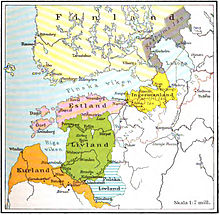
Livónia nagyobbik része, beleértve Rigát, svéd uralom alá került. Hatalmas földbirtokai a birodalom jelentős részét ellátták búzával, ezért a régiót a "svéd kenyereskorsárnak" is nevezték. Riga volt Svédország második legnagyobb városa. A svéd birodalmi politika arra irányult, hogy a Balti-tenger egész partvidékét ők uralják, ebbe a türekvésbe illett bele Livónia meghódítása is. Az észtekkel ellentétben, akik 1561-ben önként csatlakoztak Svédországhoz és ahol a helyi szokásokat és törvényeket alapvetően érintetlenül hagyták, Livóniában XI. Károly király 1680-ban elkobozta a nemesség birtokainak jelentős részét és államhoz került földeken bevezette a svéd törvényeket: megszüntették a jobbágyrendszert, a parasztok tanulhattak és engedélyezték számukra hogy katonák vagy hivatalnokok lehessenek. Amikor azonban I. Péter cár meghódította Livóniát, ezeket a reformokat felszámolták.
1632-ben Gusztáv Adolf király megalapította a Dorpati Egyetemet, amely a livóniai szellemi élet központjává vált. 1685-ben Johann Ernst Glück a svéd kormány anyagi támogatásával lett nyelvre fordította a Bibliát. Az egyházközségekben iskolát alapítottak a lett parasztság számára. A lett történetírás ezt az időszakot "régi jó svéd időkként" jegyzi.
A Kurlandi és Semgalleni Hercegség (1562–1795)[szerkesztés]

A hercegség első ura a Livóniai Rend utolsó nagymestere, Gotthard Kettler lett, a többi magasrangú rendtagból pedig a földbirtokos nemesség; bár Kettler az egész hercegség egyharmadára rátette a kezét. Mitaut nevezte ki székhelyévé, ide kívta össze a nemesi gyűlést évente kétszer.
1587-es halálát követően fiai, Friedrich és Wilhelm örökölte a hercegséget, amelyet 1596-ban felosztottak egymás között. Friedrich kapta a keleti Zemgalét Mitau székhellyel, míg Wilhelmnek a nyugati Kurland jutott, amelynek Goldingen volt a központja. Amikor Wilhelm feleségül vette a porosz herceg lányát, hozományul megkapta Grobiņa körzetét. Fejlesztette az ipart (főleg a fémművességet és hajóépítést), valamint a kereskedelmet. 1616-ban viszályba keveredett a helyi földbirtokos nemességgel, elűzték és bátyja, Friedrich vette át a helyét. Friedrichnek nem volt gyereke, így halála után Kurland Wilhelm fiára, Jakobra szállt. A hercegség az ő idejében élte fénykorát. Jakob fiatal korába bejárta Európát és megismerkedett az akkor divatos merkantilizmus eszméivel. Fejlesztette a fémművességet, a hajóépítést, lőporgyártó üzemeket alapított. A szomszédos országokon kívül Angliával, Franciaországgal, Hollandiával és Portugáliával is kereskedett. Kiépült Windau és Libau kikötője; az előbbiben 120 hajót építettek, amelyek közül több mint 40 hadihajó volt. A hercegség jelentős flottával rendelkezett és belekóstolt a gyarmatosításba is: két kolóniát alapítottak, egyiket az afrikai Gambia folyó torkolatánál, a másikat a karibi Tobago szigetén (az akkor adott földrajzi nevek egy része ma is használatos).
Az utolsó herceg, Peter von Biron idejében már nagyon erős volt az orosz befolyás. 1775-ben ő alapította az Academia Petrinát. 1786-ban a cseh Lobkovic famíliától megvásárolta a Sagan hercege címet is. 1795-ben, Lengyelország harmadik felosztásakor a cár "javaslatára" a herceg lemondott és tekintélyes összegért cserébe átengedte Kurlandot Oroszországnak.
A felvilágosodás nagy hatással volt a balti németekre is, akik közül kettő jelentős szerepet játszott a lett nemzet megteremtésében. Gotthard Friedrich Stender írta az első német-lett szótárat; emellett az első képes lett ábécéskönyvet és egy enciklopédiát is. Garlieb Merkel 1796-ben publikálta "A lettek" c. könyvét, amelyben a világ elé tárt, hogy a lett jobbágyok milyen szörnyű körülmények között kénytelenek élni könyörtelen német földesuraik uralma alatt.
-
Riga in 1612
-
Siege of Riga in 1656
-
Postal stamp in memory of Duke Jacob
-
Livonia and Courland in 1705
-
Rundāle Palace, the summer residence of Duke von Biron
-
Jelgava Palace, the main residence of Duke von Biron
Oroszország részeként (1721/95–1915/18)[szerkesztés]
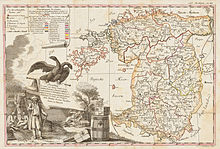
1700-ban Oroszország és Svédország között kitört az északi háború, mert I. Péter cár kijáratot akart a Balti-tengerre. Az oroszok 1710-ben elfoglalták Rigát; Észtország és Livónia ezt követően kapitulált. A háborús pusztítások mellett pestis is dúlta a térséget, amely helyenként a lakosság háromnegyedét kiirtotta.
I. Péter 1713-ban létrehozta a Rigai kormányzóságot (több adminisztratív reformot követően 1796-ben ebből alakult meg 1796-ban a Livóniai kormányzóság). A háború lezárásakor a nystadi békével Stockholm hivatalosan is lemondott livóniai birtokairól. A békeszerződés meghagyta és megerősítette a balti németek meglévő privilégiumait. Megtarthatták korábbi pénzrendszerüket, vámhatáraikat, megmaradt a nemesi gyűlések (Landtag) és a városi tanácsok önkormányzata, gyakorolhatták lutheránus vallásukat, használhatták a német nyelvet. Különleges jogállásukat I. Péter minden utódja megerősítette, egészen II. Sándorig.[9] Csak az 1889-es reform vezette be itt is az orosz törvényeket és tette kötelezővé az orosz nyelvű oktatást az iskolákban.

Lengyelország 1772-es első felosztásakor Oroszország megkapta az Inflatyi vajdaságot, amelyet először a Mogiljevi kormányzósághoz csatoltak, 1802 után pedig a Vityebszki kormányzósághoz került. Emiatt az itt élő latgalok kulturális és nyelvi szempontból is elszigetelődtek a lett nemzettől.
1795-ben, amikor harmadszor is felosztották lengyelországot, Kurland és Semgallen hercegsége is az orosz cár fennhatósága alá került. Területéből megalakították a Kurlandi kormányzóságot, ahol a németek a livóniaiakhoz hasonlóan szintén megtarthatták privilégiumaikat és autonómiájukat. Ekkorra valamennyi, lettek által lakott terület Moszkva uralma alá került.
Napóleon 1812-es oroszországi hadjárata során a vele szövetséges Yorck porosz marsall megszállta Kurlandot, megközelítette Rigát és a mesotheni csatában megfutamította az oroszokat. Napóleon kijelentette, hogy francia-lengyel protektorátus alatt visszaállítja a Kurlandi Hercegséget. Ezután öt hónapon át sikertelenül ostromolták Rigát; ez idő alatt a város kormányzója, Essen tábornok felgyújtotta a fából épült külvárost, hogy ne nyújthasson fedezéket az ellenségnek, de az elharapózó tűz több negyedet elpusztított. A tél közeledtével Yorck viszavonult.
Emancipation of peasantry[szerkesztés]

Livonian peasant law, 1804[szerkesztés]
After the October 1802 Kauguri rebellion, czarist authorities reacted with the law of February 20, 1804, which was aimed at improving peasant condition in the Livonian Governorate. Peasants no longer were tied to the land owner, but to the land, so they could be sold only together with the land. Peasants were divided in two classes – people of manors and plowmen. Plowmen were divided into farm-owners and free people. Farms from now on could be inherited within the family. Amount and length of socage now was regulated and limited. This law was opposed by the nobles, who in 1809 secured changes in the law which again gave them more power over peasants and socage.[10]
Emancipation in Courland, 1819[szerkesztés]
In 1816 Governorate of Estonia proposed a law for emancipation of serfs which was based on the model of the Prussian reforms. Czarist authorities ordered Courland Landtag to come up with a similar proposal, which was accepted on August 25, 1817, and proclaimed in Jelgava on August 30, 1818, in presence of Czar Alexander I. Emancipation came into force in 1819 and continued until 1832 as only a selected number of peasants was emancipated each year. Emancipation gave peasants personal freedom, but no land, which they had to lease from land-owners. Peasants were not completely free, as they still could not move to another governorate or city without land-lord's permit.
Emancipation in Livonia, 1820[szerkesztés]
After Emancipation in Estonia and Courland, the situation in Livonia was resolved by the law of March 26, 1819, which was very similar to the Emancipation law of Courland. It was proclaimed on early 1820 and was in force until 1832.
Emancipation in Latgale, 1861[szerkesztés]
As Latgale was part of the Russian Vitebsk Governorate, serfdom here lasted until 1861, when the Emancipation reform of 1861 was proclaimed in the Russian Empire. Initially peasants kept their land, but had to continue performing socage and rent payments. This was ended by the new law of March 1, 1863.[10]
Further reforms[szerkesztés]
After 1832 peasants were allowed freedom of settlement within the governorate, but only in 1848 Courland peasants were allowed to settle in towns and cities, many of which until then had mostly German and Jewish populations.
The provisional Livonian agrarian law of July 9, 1849 which came int force on November 20, 1850, maintained German nobility's property rights, but allowed peasants to rent or buy the land. By 1856 only 23% of farmers were paying land rent, while the rest were still performing socage. In 1860 this law became permanent and allowed increasing number of farmers to purchase their homes. An 1864 law permitted creation of credit unions, and this improved access to capital for farmers wanting to buy their homes from German land-lords. Just before the start of World War I about 99% of houses in Courland were bought and 90% in Livonia.[11] This created a land-owning Latvian farmer class which increased in prosperity and sent its sons to schools of higher education.
In 1870-80s many peasants who were unable or unwilling to purchase their land, used the opportunity to emigrate to Siberia, where land was given for free. By the start of World War I approximately 200,000 Latvian farmers had moved to farming colonies in Siberia.
Giving of family names[szerkesztés]
While there are records of Latvian last names going as far back as 15th century, almost all of them were inhabitants of large cities and often adopted Germanic family names. Some peasants had family names in the 17th century, but majority had only first name until the emancipation. Most people were identified by the name of their house or manor. Emancipation created the need for identity papers and with this, for family names. Livonian peasants had to choose family names by 1826, in Courland majority names were selected in the campaign that lasted from October 1834 until July 1835. Peasants were prohibited from choosing family names of German nobility and majority chose names related to animals, plants and trees, especially popular were diminutive forms – Bērzs (birch), Bērziņš (small birch), Kalns (hill), Kalniņš (small hill).
Religion[szerkesztés]
Latvia was predominantly Lutheran and Catholic, but in 1729 Herrnhuter Brethren started their mission in Livonia, with center in Valmiera, their missionaries made significant headway despite the opposition of the German landlords who controlled the Lutheran clergy. The Imperial government proscribed the Moravians 1743–1764. This was the first Christian movement where Latvians become involved voluntarily. Brethren operated independently from the German landlords and their meeting houses were run by Latvians, giving them a chance to create their own communities. Brethren reached the peak of their popularity around 1820, a few years after serfdom was abolished in Livonia Governorate. 30 parishes had almost 100 meeting houses and 20,000 members.
The Imperial government sponsored the Russian Orthodox Church, as part of its program of russification, but Lutheranism remained the dominant religion, except Latgale where Catholicism was dominant. Other Protestant missions had some success including the Baptists, Methodists and Seventh Day Adventists.[12]
In 1571 the first Jews were invited to settle in Piltene and a Courland Jewish community was formed. After incorporation into Russian Empire more Jews from the former Polish-Lithuanian Commonwealth settled here.
Latvian National Awakening[szerkesztés]


Latvian national awakening could start after the emancipation of serfs and growth in literacy and education rates. Educated Latvians no longer wanted to be Germanized.
In 1822 Latviešu avīzes the first weekly in Latvian began publishing. In 1832 weekly Tas Latviešu Ļaužu Draugs began publishing. The first Latvian writers who wrote in Latvian appeared – Ansis Liventāls (1803–77), Jānis Ruģēns (1817–76) and others. In 1839 institute for the elementary school teachers led by Jānis Cimze opened in Valmiera.
By the middle of 19th century, the First Latvian National Awakening began among ethnic Latvian intellectuals, a movement that partly reflected similar nationalist trends elsewhere in Europe. This revival was led by the "Young Latvians" (in Latvian: jaunlatvieši) from the 1850s to the 1880s. Primarily a literary and cultural movement with significant political implications, the Young Latvians soon came into severe conflict with the Baltic Germans. During this time the notion of a united Latvian nation was born. Young Latvians also began to research Latvian folklore (See:Latvian dainas) and ancient beliefs.
In the 1880s and 1890s the russification policy was begun by Alexander III aimed at reducing German autonomy in the Baltic provinces. Introduction of the Russian language in administration, court and education was meant to reduce predominance of German language. At the same time these policies banned Latvian language from public sphere, especially schools, which was a heavy blow to the new Latvian culture.
With increasing poverty in many rural areas and growing urbanization and industrialization (especially of Riga), a loose but broad leftist movement called the "New Current" arose in the late 1880s. It was led by the future National poet Rainis and his brother-in-law Pēteris Stučka, editors of the newspaper Dienas Lapa. This movement was soon influenced by Marxism and led to the creation of the Latvian Social Democratic Labour Party. While Rainis remained a social democrat until his death, Stučka become allied with Lenin, established the first Bolshevik state in Latvia and died in Moscow.
1905 Revolution[szerkesztés]
Latvia welcomed the 20th century with an explosion of popular discontent during the 1905 Revolution. It started with the shooting of demonstrators in Riga on January 13, progressed to mass strikes in October and armed uprising in December. The revolution was aimed not only against the czarist authorities, but against the hated German barons. For in Latvia most did not feel primarily oppressed by Russia or Russians, but by the Baltic Germans —roughly seven percent of the population— who had instituted a feudal system with themselves at the top and Latvian-speakers being left mostly poor and landless.[13] As such, it involved not only left wing social democrats and industrial workers, but also more conservative peasants and Latvian intelligentsia since —despite being second class citizens in their own country— Latvia was also a highly literate and industrialised society. Riga was behind only St. Petersburg and Moscow by the number of industrial workers, and at the turn of the century over 90% of Latvians could read.[13] In this regard, Latvia was equally primed for radical leftism and nationalism. In all, spearheaded by the Latvian Social Democratic Workers’ Party (LSDSP), the governorates making up what is now Latvia were probably the most ungovernable in the whole Russian Empire.[13]
Following the shooting of demonstrators in St. Petersburg on January 9, 1905, a wide-scale general strike began in Riga. On January 13 Russian army troops opened fire on demonstrators in Riga killing 73 and injuring 200 people.
During the summer of 1905 the main revolutionary events moved to the countryside. 470 new parish administrative bodies were elected in 94% of the parishes in Latvia. The Congress of Parish Representatives was held in Riga in November. Mass meetings and demonstrations took place including violent attacks against Baltic German nobles, burning estate buildings and seizure of estate property, including weapons. In total 449 German manor houses were burned.
In the autumn of 1905 armed conflict between the German nobility and the Latvian peasants began in the rural areas of Vidzeme and Courland. In Courland, the peasants seized or surrounded several towns where they established revolutionary councils. In Vidzeme the fighters controlled the Rūjiena-Pärnu railway line. Altogether, a thousand armed clashes were registered in Latvia in 1905.[14]
Martial law was declared in Courland in August 1905 and in Vidzeme in late November. Special punitive expeditions by Cossack cavalry units and Baltic Germans were dispatched in mid-December to suppress the movement. They executed over 2000 people without trial or investigation and burned 300 houses and public buildings. The executed often were local teachers or peasant activists who had shown disrespect to German nobles, not necessarily hardened revolutionaries. 427 people were court martialed and executed. 2652 people were exiled to Siberia, over 5000 went into exile to Western Europe or the US. In 1906 the revolutionary movement gradually subsided but some local protests and actions of forest guerrillas continued until 1907. They executed some daring raids – freeing their imprisoned comrades from Riga police HQ on January 17, 1906, February 26, 1906 Helsinki bank robbery and the 1910 Siege of Sidney Street in London.
Among the exiles were activists from the left and right who in just 10 years would fight against each other over the future of Latvia, such as the future Prime Minister Kārlis Ulmanis, National poet Jānis Rainis and early Cheka leader Jēkabs Peterss.
-
Jānis Rainis, ca. 1900
-
Latvian workers against a Cossack, Freedom Monument
-
Monument to the victims of January 13, 1905
-
The burned Allaži manor house
World War I[szerkesztés]

On August 1, 1914, Germany declared war on Russia. Since Courland Governorate had a direct border with Germany it was immediately involved in warfare. On August 2 German warships SMS Augsburg and SMS Magdeburg shelled port city Liepāja, causing it light damage. On August 19 German navy tried to capture Užava Lighthouse but were repelled, after which German artillery destroyed it. In October British submarines HMS E1 and HMS E9 from the British submarine flotilla in the Baltic arrived in Liepāja. On November 17 German navy again shelled Liepāja and military installations of Karosta damaging some 100 buildings.
Many Latvians served in the Russian units stationed at German border and took part in Russian invasion of East Prussia. They participated in the early battles of First Battle of the Masurian Lakes, Second Battle of the Masurian Lakes and Battle of Augustow; total Latvian losses during these battles might have reached 25,000 dead.[15]
German attack and refugees[szerkesztés]
By May 1915 the war reached most of Latvia. On April 30 Russian Commander-in-Chief ordered the evacuation of all Jews from Courland within 24 hours. On May 2, 1915, German attack against Jelgava was repelled. On May 7 the Germans captured Liepāja and Kuldīga.
On June 29 the Russian Supreme Command ordered the whole population of Courland evacuated, and around 500,000 refugees fled to the east. Much of the crops and housing was destroyed by the army to prevent them from falling into the German hands. Some of the refugees settled in Vidzeme but most continued their way to Russia where they had to settle in primitive conditions, suffering from hunger and diseases. In August 1915 the Latvian Refugee Aid Central Committee was established in Petrograd, it was run by future politicians Vilis Olavs, Jānis Čakste and Arveds Bergs. Committee organized refugee housing, organized 54 schools, 25 hospitals and distributed aid. Many refugees returned to Latvia only after 1920, when a peace treaty was signed between Latvia and Soviet Russia. Many Latvians stayed in the new Bolshevik state, achieving high army and party offices, only to be purged and executed by Stalin during 1937–38.
On July 19, 1915, the Russian War Minister ordered the factories of Riga evacuated together with their workers. In the summer of 1915, 30,000 railway wagons loaded with machines and equipment from factories were taken away reducing the population of Riga by some 50%. This action effectively destroyed Riga as a great industrial center until the later industrialization under the Soviet regime.
On August 1, the Germans captured the capital of Courland, Jelgava. A week later Battle of the Gulf of Riga started and eventually was lost by Germany. By October 23, Germans captured Ilūkste and were within the striking distance of Daugavpils with its fortress.
Latvian Riflemen[szerkesztés]
After on July 17 and 18, 1915 Germans captured Dobele, Talsi, Tukums and Ventspils, a public proclamation by State Duma members, written by Kārlis Skalbe, called for the formation of volunteer Latvian Riflemen units. In August the formation of Latvian battalions started. From 1915 to 1917, the Riflemen fought in the Russian army against the Germans in defensive positions along the Daugava River, notably the Nāves sala (Island of Death) bridgehead position. In December 1916 and January 1917, they suffered heavy casualties in month-long Christmas Battles. Many of them were buried in the newly created Riga Brothers' Cemetery.
After the great offensive of 1915, the front line stabilized along the Daugava river until the Russian army started to collapse in early 1917. In February 1917 Revolution broke out in Russia and in the summer the Russian army collapsed. By this time the Riflemen had overwhelmingly transferred their allegiances to the Bolsheviks.[13] The following German offensive was successful and on September 3, 1917, they entered Riga.
In November 1917, the Communist Bolsheviks took power in Russia. Even though ethnic Latvians had become important assets in the task of securing Soviet power military (with the first ever commander-in-chief of the Red Army being Latvian Jukums Vācietis)[13] the Bolshevik government tried to end the war and in March 1918, the Treaty of Brest-Litovsk was signed which gave Courland and Livland Governorate to the Germans, who quickly established occupational regime which lasted until November 11, 1918. During this time Germans tried to create the United Baltic Duchy in perpetual union with the Crown of Prussia.
War damages[szerkesztés]
A survey in 1920 established that 56,7% of parishes had war damages. Population had decreased from 2,55 million to 1,59 million. The number of ethnic Latvians has never again reached the 1914 levels. 87,700 buildings were destroyed. 27% of the arable land laid in waste. Much of the industry was evacuated to Russia and lost forever. Ports were damaged by sunken ships, bridges blown up and railways damaged. 25,000 farms were destroyed, 70,000 horses, 170,000 cattle lost.[16]
-
SMS Augsburg on August 4, 1914
-
Volunteer riflemen, 1915
-
Ilūkste before destruction in 1915
-
Riga Brother's Cemetery
-
German troops in Liepāja, May 1915
-
German parade in Riga, 1917
-
German troops on Riga railway bridge
Competing statehood movements, 1917–20[szerkesztés]

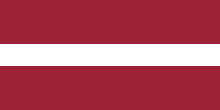

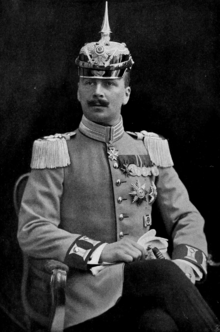
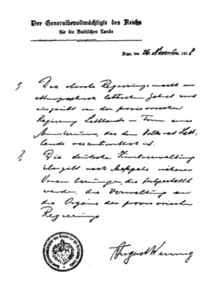





The course of World War I, which directly involved Latvians and Latvian territory, fostered the idea of Latvian statehood. During the summer of 1915 the German army conquered Kurzeme and Zemgale, leading to an exodus of Latvians from these two provinces. Local politicians gained experience organizing refugee relief and Latvian refugee cultural life. Caught between the attacking Germans and incompetent Russians, Latvian riflemen (latviešu strēlnieki) fought on the Russian side during this war and became increasingly radicalized after repeated setbacks under tsarist generals. During the Russian Civil War of 1917-1923 a significant group (known as Red riflemen) fought for the Bolsheviks. Meanwhile, German-Empire and local Baltic Germans planned to annex the ancient Livonian and Estonian lands to the German state. During the chaotic period of Russian and German empire collapses, the February Revolution of March 1917, the Bolshevik revolution of November 1917, the Soviet westward offensive of 1918–19 and the onset of the Russian Civil War, Latvians made various efforts to establish a local government. Not all of these efforts aimed at establishing an independent state or even a Latvian state.
Provisional Land Councils[szerkesztés]
After the February Revolution in the Russian Empire, a majority of Latvians did not expect more for their country than a federated status in a Russian state. "Free Latvia in Free Russia" was the slogan of the day. During March 12–13, 1917 in Valmiera the Vidzeme Land Congress took place, which set up the Provisional Land Council of Vidzeme. Courland was occupied by Germans, who increasingly supported idea of creating a puppet Duchy of Courland and Semigallia in order to annex it to Germany. Latgalian-inhabited counties of the Vitebsk Governorate were demanding unity with other Latvian provinces (unification of Latgalian Latvians and Baltic Latvians), which came only after the Bolshevik revolution.
Iskolat[szerkesztés]
On July 5, 1917, the Russian Provisional Government recognized the elected Land councils of Vidzeme and Kurzeme. Encouraged by the liberalism of the Provisional Government, Latvians put forward proposals which envisioned a broad local autonomy. On August 12, 1917, Latvian organizations jointly asked the Provisional Government in Petrograd for autonomy and self-determination. During a Congress from August 11–12 (July 29–30, Old Style) in Riga, the left-wing Social Democrats, heavily influenced by the Bolsheviks, established the Iskolat government - named for the "Executive Committee of the Council of Workers, Soldiers and Landless Deputies of Latvia" (Sablon:Lang-ru).
When the German Army occupied Riga on September 3, 1917, Iskolat retreated to Vidzeme, where it assumed executive powers. The so-called Iskolat Republic existed from November 21, 1917, until March 3, 1918. Under German attacks it evacuated to Cēsis, then to Valka. It disbanded in March 1918 after the Brest-Litovsk treaty of March 3, 1918 assigned the Latvian lands (except Latgale) to Germany.
Democratic bloc[szerkesztés]
In German-occupied Riga, after a preliminary meeting on September 14, on September 23, 1917, the Latvian Social Democratic party, together with the Latvian Farmers' Union and some smaller republican and socialist parties, formed the Democratic Bloc, which petitioned Ober Ost for the restoration of an elected Riga City Council, the re-opening of schools, and press freedoms. The Democratic Bloc was not a formal organization, but a coalition of politicians who shared similar political goals.
Latvian Social Democrats used their old contacts with the German Social Democrat Party to directly lobby politicians in Berlin. On October 19, 1918, Democratic Bloc representatives delivered a petition to the German Imperial chancellor Prince Maximilian of Baden, in which they asked for the removal of occupational forces, the release of POWs, and recognition of an independent Latvian state.
Latvian National Council[szerkesztés]
In October 1917 centrist politicians met in Petrograd and agreed to create a united council of all Latvian parties, refugee-support organizations and soldiers' committees. On November 29, 1917, the Latvian Provisional National Council was established in Valka. On December 2, 1917, it proclaimed Latvia's autonomy in Latvian-inhabited lands and declared itself the only representative organ of Latvians. The council announced three main goals – convening of a Constitutional Assembly, creation of political autonomy and uniting of all ethnic Latvian-inhabited lands.
The National Council, under the chairmanship of Voldemārs Zāmuēls, sent a delegation - led by the future Minister of Foreign Affairs Zigfrīds Anna Meierovics - to the Allied countries to get their support for an independent Latvia.
The Provisional National Council operated in the same place and at the same time as the Bolshevik-controlled Iskolat – in the small city of Valka, which is situated on the border between ethnic Estonian and ethnic Latvian lands, and which for a couple of months was the virtual capital of the Latvians. Iskolat moved to ban the Provisional Council in December 1917.
On January 5, 1918, during the only meeting of the democratically elected Constituent Assembly of Russia (subsequently dissolved by Bolsheviks), Latvian deputy Jānis Goldmanis, the initiator in 1915 of the formation of the Latvian Riflemen units, read a declaration of separation of Latvia from Russia.
At its second meeting, which took place in Petrograd, the Latvian National Council on January 30, 1918, declared that Latvia should be an independent, democratic republic, uniting the Latvian regions of Kurzeme (which includes Zemgale), Vidzeme and Latgale.
On March 3, 1918 Soviet Russia signed the treaty of Brest-Litovsk with the Central Powers. In terms of the treaty Russia gave up Kurzeme and Vidzeme (but not Latgale). The National Council protested against the splitting of Latvian lands and the annexation of Kurzeme by Germany.
On November 11, 1918, the British Empire recognized the Latvian National Council as a de facto government, confirming a prior verbal communication of October 23 to Zigfrīds Anna Meierovics from the British Minister for Foreign Affairs, A. J. Balfour.[17]
Despite these diplomatic successes, the National Council had a major problem: the Social Democrats and the Democratic Bloc refused to join it. This prevented the creation of a truly national consensus for proclaiming independence. This disunity came to an end only on November 17, 1918, when the People's Council (Tautas padome) was created.
United Baltic Duchy[szerkesztés]
On September 22, 1918, German Emperor Wilhelm II proclaimed the Baltic provinces to be free and on November 5 Germans proclaimed a United Baltic Duchy headed by Duke Adolf Friedrich of Mecklenburg. However, this project (just like the similar Kingdom of Lithuania) collapsed together with the German Empire on November 9 and with the Armistice of 11 November 1918.
On November 26, 1918, the new General Plenipotentiary of Germany August Winnig recognized the Latvian Provisional Government which the People's Council had established on November 18. On November 28 the Regency Council of the United Baltic Duchy disbanded itself.
People's Council[szerkesztés]
After the German collapse on November 9, the National Council and the Democratic Bloc began unification talks. Social Democrats insisted that the new Latvia should be a socialistic state, which other parties found unacceptable. The Social Democrats also refused to join the National Council, instead insisting on creating a new unity organization. The unification talks were led by Farmers' Union leaders Kārlis Ulmanis and Miķelis Valters, while National Council leaders Voldemārs Zāmuēls, Arveds Bergs and Ādolfs Klīve were sidelined.[18]
On November 17, 1918, competing Latvian factions finally united in the People's Council, which on November 18, 1918, proclaimed the independence of the Republic of Latvia and created the Latvian Provisional Government.
On November 18 Soviet Russia started a westward offensive aimed at regaining Russia's western provinces, and the War of Independence ensued.
The left wing of the Latvian Social Democrats had become allied with the Bolsheviks, and during its conference of November 18–19, 1918 proclaimed the Latvian commune a part of the Russian Soviet Federation.
War of Independence[szerkesztés]
On December 1, 1918 Soviet Russia invaded Latvia. Much of the invading army in Latvia consisted of Red Latvian Riflemen, which made the invasion easier. The Soviet offensive met little resistance, coming just a few weeks after the collapse of the German Empire and the proclamation of an independent Latvia. The Social Democratic party at this point decided to leave the People's Council - it rejoined it only in April 1918. On December 17, 1918, the Provisional government of Workers and Peasants, led by the veteran left-wing politician Pēteris Stučka proclaimed Soviet rule. On December 18 Lenin officially recognized the new Soviet Latvia.
The Soviet Army captured Riga on January 3, 1919. By the end of January the Provisional Government and the remaining German units had retreated all the way to Liepāja, but then the Red offensive stalled along the Venta river. The Latvian Socialist Soviet Republic was officially proclaimed on January 13 with the political, economic, and military backing of Soviet Russia. Stučka established a radical communist régime of nationalizations, expropriations and executions of class enemies. Revolutionary tribunals were established, condemning to death German nobles, pastors, and wealthy traders - as well as peasants who refused to surrender their grain: in total some 1000 people were executed. Due to food-supply disruptions, 8590 people starved to death in Riga.
On March 3, 1919 German and Latvian forces commenced a counterattack against the forces of Soviet Latvia. On April 16 the Baltic nobility organized a coup d'état in Liepāja and a puppet government under the leadership of Andrievs Niedra (in office from 26 April 1919) was established - it lasted for just two months. The provisional national government took refuge aboard the steamship Saratov under British protection in Liepaja harbour.[19] On May 22, 1919, the German Freikorps under the overall command of the German Major-General Rüdiger von der Goltz recaptured Riga, and the White Terror against any suspected Soviet sympathizers began. At the same time the Estonian Army (including the North Latvian Brigade loyal to the Latvian Provisional Government headed by Ulmanis) started a major offensive against the Soviets in north Latvia. By the middle of June Soviet rule was reduced to Latgale.
In June 1919 collisions started between the Baltische Landeswehr on one side and the Estonian 3rd division (including the 2nd Cēsis regiment of the North Latvian brigade) on the other.[20] The 3rd division defeated the German forces in the Battle of Wenden on June 23. An armistice was signed at Strazdumuiža, under the terms of which the Germans had to leave Latvia.[20]
Instead the German forces were incorporated into the West Russian Volunteer Army.[20] On October 5 it commenced an offensive on Riga, taking the west bank of the Daugava River - the front line split Riga in half. On November 11 the Latvian counteroffensive began and by the end of the month the West Russian Volunteer Army was driven from Latvia. During battles in Riga, Latvian forces were supported by British naval artillery.
On January 3, 1920, the united Latvian and Polish forces launched an attack on the Soviet army in Latgale, and in the Battle of Daugavpils liberated Daugavpils by January 5. By the end of January they reached the ethnographic border of Latvia, and peace negotiations with the Soviets soon began.
Peace and international recognition[szerkesztés]
During the 1919 Paris Peace conference Latvia had unsuccessfully lobbied for international de jure recognition of its independence by the Allied countries. The Allies still hoped for a quick end of the Bolshevik regime in Moscow and the establishment of a democratic Russian state which would grant Latvia a large degree of autonomy. The internal situation also was unstable, as during 1919 three different governments (Latvians, Germans-White Russians, and Soviets) were fighting for control.
According to Latvian diplomats, during that time the US and France opposed recognizing Latvia; Italy and Japan supported the idea; while the United Kingdom gave limited support and waited for events to play out.
On August 11, 1920, according to the terms of the Latvian–Soviet Peace Treaty, Soviet Russia relinquished authority over the Latvian nation and its claims to Latvian territory:
"Russia recognizes without objection the independence and sovereignty of the Latvian State and forever renounces all sovereign rights held by Russia in relation to the Latvian nation and land on the basis of the previous State legal regime as well as any international agreements, all of which lose their force and effect for all future time as herein provided. The Latvian nation and land shall have no obligations arising from their previous possession by Russia."[21]
In 1920 Latvia, together with Lithuania and Estonia, applied to join the League of Nations but was denied membership at that time.
As the Soviet victory in the Russian Civil War became clear and after heavy lobbying by the Latvian Foreign Minister Zigfrīds Anna Meierovics, the Allied Supreme War Council, which included United Kingdom, France, Belgium, Italy and Japan, recognized Latvia's independence on January 26, 1921.[22] Recognition from many other countries soon followed. Latvia became a member of the League of Nations on September 22, 1921. The US recognized Latvia only in July 1922. Before 1940, a total of 42 countries recognized Latvia.[23]
Parliamentary era, 1920–34[szerkesztés]
After Latgale was finally liberated from the Soviets in January 1920, elections to the Constitutional Assembly of Latvia took place on April 17–18, 1920. While the population of Latvia had fallen by almost a million, from 2,552,000 to 1,596,000 in 1920 (in Riga from 520,000 to 225,000), 50 party-lists and candidates competed for 150 seats. Close to 85% of eligible voters participated in the elections, and 16 parties were elected. The Social Democratic Workers' Party won 57 seats, the Farmers' Union 26, and the Latgalian Peasant Party 17. This voting pattern marked all the future parliaments – a high number of parties representing small interest-groups required the formation of unstable coalition governments. While the largest single party, the Social Democrats, held the post of Speaker of the Saeima, they avoided participating in governments. Between 1922 and 1934 Latvia had 13 governments and 9 Prime Ministers.
On February 15, 1922, the Constitution of Latvia and in June the new Law on Elections were passed, opening the way to electing the parliament – the Saeima.
During the parliamentary era, four national elections took place, which elected the 1st Saeima (1922–25), 2nd Saeima (1925–28), 3rd Saeima (1928–31), and 4th Saeima (1931–34). Three State Presidents were elected – Jānis Čakste (1922–27), who died in office; Gustavs Zemgals (1927–30), who refused to stand for re-election; and Alberts Kviesis (1930–36), who accepted the May 15 coup d'état.
Border conflicts[szerkesztés]
Eastern[szerkesztés]
The Latvian-Soviet peace treaty had set the eastern border between Latvia and Soviet Russia. After 1944 the Soviet Union annexed parts of Abrene District as the Pytalovsky District of the RSFSR. Latvia gave up all legal claims to these lands in 2007.
Northern[szerkesztés]
During 1919 Estonia had provided military assistance to Latvia on the condition that some of its territorial claims in Vidzeme would be met. The Latvians refused, and Estonia withdrew its support. Estonian claims centered on Valka district as well as territories in Ape, Veclaicene, Ipiķi and Lode. On March 22, 1920, Estonia and Latvia agreed to a settlement commission led by British colonel Stephen Tallents. Latvia retained Ainaži parish, and most of other contested lands, but lost most of Valka city (now Valga, Estonia). The issue of the ethnically Swedish-inhabited Ruhnu island in the Gulf of Riga was left for both countries to decide. Latvia finally renounced all claims on Ruhnu island after signing a military alliance with Estonia on November 1, 1923.[24]
Southern[szerkesztés]
Latvia proposed to retain the southern border of the former Courland governorate with Lithuania unchanged, but the Lithuanians wanted to gain access to the sea, as at this time they did not control the German lands of Klaipėda. In September 1919, during an attack against the Soviets, the Lithuanian army occupied much of Ilūkste Municipality and threatened to take Daugavpils as well. Between late August and early September 1920 the Latvian army pushed the Lithuanians out.[25] The Lithuanians, weakened by Żeligowski's Mutiny of October 1920, did not escalate this confrontation. On September 25, 1920, Latvia and Lithuania agreed to have an international arbitration committee led by James Young Simpson settle this dispute. In March 1921, Lithuania was given the port town Palanga, the village of Šventoji, parts of Rucava Municipality and the railroad junction of Mažeikiai on Riga – Jelgava – Liepāja railroad line, which meant that Latvia had to build a new railway line. Latvia received the town of Aknīste and some smaller territories in the Aknīste Municipality, Ukri parish and Bauska Municipality. Latvia gave up 283,3 square km, while receiving 290 km2. About 16 to 20 thousand ethnic Latvians thus became Lithuanian citizens.
As a result of the Polish–Soviet War of 1918–1921, Poland secured a 105 km long border with Latvia. In July 1919 Poland announced its annexation of all lands south of Daugavpils and their inclusion in Braslaw district. Latvia could not complain, as it still needed Polish military help prior to the decisive Battle of Daugavpils of January 1920 against the Soviets. The issue was solved by a renewed Soviet attack against Poland, and later, by Polish-Lithuanian conflict over Vilnius. During the Soviet attack in July 1920, Polish forces retreated from this area, which Latvian forces then occupied. After Żeligowski's Mutiny Poland wanted to have good diplomatic relations with Latvia and did not raise any serious territorial claims. The issue was solved in February 1929, when Latvia and Poland signed a trade treaty which included a secret agreement about compensation to Polish landowners for lost properties. By 1937 Latvia had paid the full amount of 5 million golden lats.[26] Over some protests from Lithuania, the Latvian-Polish border was demarcated between 1933 and 1938.
Foreign relations[szerkesztés]
Independent Latvia's earliest foreign-policy goals involved securing peace with Soviet Russia and with Germany, gaining international recognition, and joining the League of Nations. All this was achieved by the efforts of Zigfrīds Anna Meierovics.
Hopes for the union of Baltic countries – Poland, Lithuania, Latvia, Estonia, and Finland – faded after 1922. After that Latvia was the most energetic proponent of Baltic unity and Baltic Entente. On November 1, 1923, Latvia and Estonia signed a military alliance, followed by trade agreements. Latvia tried to maintain good relations with the regional hegemons - Soviet Russia and Germany - and hoped for more support from Great Britain. Foreign governments opened 21 embassies and 45 consulates in Latvia by 1928; some of these consulates were located in the port cities Liepāja and Ventspils.
Latvia purchased embassy buildings in Berlin (1922), Tallinn, Warsaw (1923), London (1925), Paris (1927), and Geneva (1938).[27]
Politics[szerkesztés]
The Social Democratic Workers' Party, as the largest party, held the position of the Speaker of the Saeima in all the interwar Saeimas. The 1st Saeima was chaired by Frīdrihs Veismanis, the Second, Third and Fourth Saeimas were chaired by Pauls Kalniņš. The refusal of the Social Democrats to participate in governments (except twice in short-lived cabinets) meant that government was usually led by the center-right Farmers' Union, or by a coalition of smaller parties, as the Saeima seats were divided among many parties, each with just a few MPs.
The Social Democrats were split between the main Social Democratic Workers' Party led by Pauls Kalniņš, Ansis Rudevics and Fricis Menders (which first won 30 seats but had a tendency to lose votes in subsequent elections) and the splinter Social Democrat Minority Party led by Marģers Skujenieks, who were more centrist and managed even to lead governments on two occasions. The mainstream Social Democrat party maintained a strong policy of Socialist International ideals and criticized the existing capitalist system. The Party avoided using the State flag and singing the National anthem, instead using the Red flag and singing the "Internationale" in their meetings. Their popularity increasingly fell, and in the 4th Saeima they had only 21 seats.
Officially banned, the Communist Party of Latvia in the 1928 elections managed to get 5 seats standing as the Left Trade Union (which was banned in 1930). In the 1931 elections Communists won 6 seats as the Trade Union Workers and Peasants Group, but were once again banned in 1933.
The Latvian Farmers' Union, comprising the second-largest parliamentary faction with 14 to 17 MPs, was the largest of the conservative parties. It increasingly had to compete with some smaller farmer, catholic-farmer and Latgale-farmer parties which won more votes in each election. The Farmer's Union was led by Kārlis Ulmanis, Zigfrīds Anna Meierovics and Hugo Celmiņš. The decreasing popularity of Ulmanis and of the Farmers' Union may have been one of the reasons behind the May 15, 1934 Latvian coup d'état, as Ulmanis tried to prevent further loss of his political influence and power in the elections scheduled for October 1934.
The Democratic Centre Party, led by Gustavs Zemgals represented mostly urban, middle-class office-workers and state employees.
The National Union, led by Arveds Bergs, was nationalistic, anti-Soviet, center-right party that attracted urban followers. The extreme nationalists were represented by the antisemitic Pērkonkrusts (founded in 1933), led by Gustavs Celmiņš.
Most of the remaining small parties were either ethnic – German, Jewish, or Polish – or represented single-issue economic groups – small-holders, house owners, even railroad workers. The small parties usually formed larger coalitions (blocks) and then used their influence to join governing coalition. One of the most influential was coalition of Latgale parties.[28]
Referendums[szerkesztés]
During this time four referendums took place, all indicative of the issues facing the new state.
On July 19, 1922, Latvia signed a Concordat with the Vatican. This was motivated by the need to better integrate the heavily Catholic Latgale in the Lutheran-dominated state. In traditionally Lutheran Riga some buildings belonging to Russian Orthodox Church were given to Catholics, and the Lutheran St. James's Cathedral was transferred to Catholics as their new cathedral. On September 1–2, 1923 the Church property referendum was held in an attempt to prevent any further forcible transfer of churches and properties from one confession to another. About 200,000 or 20% of voters participated, and the referendum failed.
On June 2, 1927, the Saeima once again changed the Citizenship law. An earlier version had granted Latvian citizenship to anyone who had lived in Latvia for 20 years before August 1, 1914 (at the start of World War I). The new law shortened the period of eligibility to 6 months before August 1, 1914. This mainly aimed to allow many Latvian farming colonists, who now were fleeing Soviet Russia, to receive citizenship. However, this also meant that many Soviet Jews now could claim Latvian citizenship. On December 17–18, 1927 the Latvian citizenship referendum was held to prevent the proposed changes, but it failed, as only 250,000 or 20% of voters participated.
The Concordat with the Vatican occasioned another church-property referendum in 1931. When the St. James's Cathedral was given to Catholics, Latvian Lutherans lost their bishop's cathedral and were sharing the Riga Cathedral with the Baltic German congregation, which belonged to the autonomous German Lutheran confession. Anti-German sentiment was widespread and an initiative to give Riga Cathedral to Latvian Lutherans gained strength. On September 5–6, 1931 almost 400,000 voters supported this idea, but the referendum failed, as it did not gather over 50% of votes. In any case, the Saeima soon passed a law confiscating the church from the Germans and giving it to the Latvians.
On February 24–25, 1934 the Insurance Law referendum took place, aiming to introduce a new old-age- and unemployment-benefit scheme which would be funded by taxing employers, higher-wage earners and municipalities. The referendum was initiated by Social Democrats, who managed to get over 400,000 votes for this idea, but the referendum failed.[29]
Economy[szerkesztés]
The young Latvian state had to deal with two main economic issues: the restoration of industrial plants (especially in Riga), and the implementation of land reform that would transfer most of the land from German nobles to Latvian farmers.
The Constituent Assembly passed a land-reform law which expropriated manor lands. Landowners were left with 50 hectares each, and their land was distributed to the landless peasants without cost. In 1897, 61.2% of the rural population had been landless; by 1936, that percentage had reduced to 18%. The extent of cultivated land surpassed the pre-war level as early as 1923.[30]
Before the World War I some 2% of landowners owned 53% of land in Kurzeme and Vidzeme, in Latgale it was 38%. The Agrarian reform Law of September 16, 1920 created the State Land Fund, which took over 61% of all land. The German nobles were left with no more than 50 ha of land. This destroyed their manor-house system. Many of them sold their possessions and left for Germany. Former manor-house buildings often became local schools, administrative buildings or hospitals. The land was distributed to a new class of small-holding farmers – over 54,000 Jaunsaimnieki (New farmers) with an average farm-size of 17.1 ha, who usually had to establish their farms from nothing, in the process building new houses and clearing fields. Due to their small size of their holdings and unfavorable grain-prices, the new farmers rapidly developed dairy farming. Butter, bacon and eggs became new export industries. Flax and state-owned forests were other export-revenue sources.[16]
On March 27, 1919, the Latvian Provisional Government introduced the Latvian ruble, with an exchange rate of 1 Latvian ruble equal to 1 Ostrubel, 2 German marks and 1.5 tsarist ruble. On March 18, 1920, the Latvian ruble became the only legal currency. Due to high inflation, the new Latvian lats was introduced in 1922 at a rate of one lats to 50 rubles. In 1923 the Bank of Latvia was established and the lats replaced the ruble entirely in 1925.
Between 1923 and 1930 the state budget ran surpluses. On average, 25.5% went to defense, 11.2% to education and 23.4% to capital-investment projects. The state's spirits monopoly generated around 15% of government income.
The restoration of industry proved complicated. Before World War I, 80% of industrial production went to internal (Russian Empire) markets. Latvia signed a trade agreement with the Soviet Union in 1927, but this did not result in high trade-volumes. By the end of the 1920s Latvia's largest export markets were Germany (35.6%), the United Kingdom (20.8%), France, Belgium, Netherlands (22.9%). Latvia had to import almost all its modern machinery and fuels.[16]
In 1929 Latvia had three state-owned banks, 19 private banks, 605 credit unions and many more mutual credit unions.
The Great Depression reached Latvia in the middle of 1930. Exports fell and imports were strictly limited, to save foreign exchange reserves. State monopolies of sugar and bacon were created. To prevent banks from collapse, between July 31, 1931, and September 1, 1933, a law prohibited withdrawal of more than 5% of the total deposit per week. In 1932 the trade agreement with Soviet Union expired and industrial unemployment reached its peak in January 1932. The national income fell from 600 lats per capita in 1930 to 390 lats per capita in 1932.
In place of free international trade came interstate clearing-agreements which set the volumes and types of goods that states then would trade. In 1932 Latvia signed clearing agreements with France and Germany, in 1934 with the United Kingdom, in 1935 with Sweden, Estonia and Lithuania.
Economic recovery started in 1933 as production increased by some 30%. The state budget deficit fell from the record 24.2 million lats in 1931/32 to 7.8 million lats in the 1933/34 budget.[16]
-
Constitutional Assembly commemorative stamp
-
1 ruble note
-
2 lats coin
-
The iconic design of 5 lats coin still used in Latvian euro coins
Ulmanis dictatorship, 1934–40[szerkesztés]
On the night from May 15 to 16, 1934 the Prime Minister Kārlis Ulmanis and Minister of War Jānis Balodis, fathers of Latvian independence, took power by a bloodless coup d'état. Parliament and Constitution were suspended, State of War introduced, all political parties banned and press censorship established. Members of the Pērkonkrusts, Latvian Social Democratic Workers' Party, pro-Nazi activists from the Baltic German community, and other leaders from the extreme right and left were detained. Certain extremist political figures such as Gustavs Celmiņš were sentenced to imprisonment.
Economy[szerkesztés]
Just as in politics, in economy, the new Ulmanis regime was very active in increasing state control and planning mechanisms. In 1934 regime created the Chamber of Trade and Industry was established, followed by the Chamber of Agriculture and the Chamber of Artisans in 1935 and the Chamber of Labour in 1936. The state helped bankrupt farmers by postponing bankruptcy auctions and refinanced their debt at a lower rate. On May 29, 1934, the state took control over cooperative societies and associations. The dairy industry was placed under the control of the Central Union of Dairy Farmers.[16]
On April 9, 1935, a state controlled Credit Bank of Latvia was created which reduced the role of foreign capital by creating many state owned industry monopolies and joint stock companies. Buyouts and liquidations of foreign, Baltic German and Jewish owned companies become a norm. In place of many competing companies large state owned companies were created. In 1939 the state owned 38 such companies. The new JSC Vairogs produced railway carriages and Ford-Vairogs automobiles under the Ford licence. VEF made world's smallest Minox cameras and such experimental aircraft as VEF JDA-10M, VEF I-12 and others. Between 1936 and 1939 the Ķegums Hydroelectric Power Station, with 70,000 kWh capacity largest in the Baltics, was built by Swedish companies.
After Western countries abandoned the gold standard, the Latvian lats was pegged to the British pound in September 1936. It was a devaluation that further strengthened Latvian exports. By 1939, following an export boom propelled primarily by agricultural goods, Latvia was the richest of the Baltic countries, and had a GDP per capita higher than Finland or Austria.[13]
However, the recovery from the Great Depression took almost ten years. National income was 444 lats per capita in 1933 and reached 637 lats per capita in 1938, thus finally overtaking the 1929 levels.[16]
After the start of World War II Latvia declared complete neutrality, but it was now completely cut off from the market of United Kingdom, as Germany had sealed off the Baltic sea. Austerity was introduced on September 3, 1939. The politically disastrous October 5, 1939 Soviet–Latvian Mutual Assistance Treaty provided new export and import opportunities. On October 18, 1939, a new trade agreement was signed with the Soviet Union. Latvia exported its food products in return receiving oil, fuel and chemicals. On December 15, 1939, a new trade agreement was also signed with the Nazi Germany.
Latvian farmers had traditionally relied on seasonal farmworkers from Poland, this was now cut off by the war, and in spring 1940 new regulations introduced compulsory work service for state employees, students and school pupils.
Foreign relations[szerkesztés]
In October 1936 Latvia was elected as non-permanent member of the Council of the League of Nations and retained this place for three years. In 1935 embassy in Washington was re-opened, which later served as important center for Latvian Diplomatic Service during 50 years of Soviet occupation.
After the Munich Agreement demonstrated the failure of collective security system, Latvia on December 13, 1938, proclaimed absolute neutrality. On March 28, 1939, Soviet Union without any discussions announced that it is interested in maintaining and defending Latvia's independence. On June 7, 1939, Latvia and Germany signed non-aggression treaty.
-
Minox camera, world's smallest
-
Ford-Vairogs trucks
-
Ford-Vairogs V8
-
VEF I-12
-
Baltic Entente meeting, 1937
-
Latvian, German and Estonian ministers sign non-aggression treaties, 1939
World War II[szerkesztés]
Soviet occupation under the Molotov–von Ribbentrop Pact[szerkesztés]
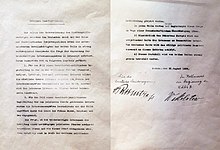
The Soviet Union prepared for Soviet annexation of Baltic countries with the signing of the Molotov–Ribbentrop Pact between the Soviet Union and Nazi Germany on August 23, 1939. Under threat of invasion,[note 1] Latvia (along with Estonia and Lithuania) signed the Soviet–Latvian Mutual Assistance Treaty with Soviet Union, providing for the stationing of up to 25,000 Soviet troops on Latvian soil. Following the initiative from Nazi Germany, Latvia on October 30, 1939, concluded an agreement to "repatriate" ethnic Germans, most of whom had lived in the region for generations, in the wake of the impending Soviet takeover.
Seven months later, the Soviet foreign minister Vyacheslav Molotov accused the Baltic states of conspiracy against the Soviet Union. On June 16, 1940, threatening an invasion,[note 2] Soviet Union issued an ultimatum demanding that the government be replaced and that an unlimited number of Soviet troops be admitted.[33] Knowing that the Red Army had entered Lithuania a day before, that its troops were massed along the eastern border and mindful of the Soviet military bases in Western Latvia, the government acceded to the demands, and Soviet troops occupied the country on June 17. Staged elections were held July 14–15, 1940, and the results were announced in Moscow 12 hours before the polls closed; Soviet documents show the election results were forged. The newly elected "People's Assembly" declared Latvia a Socialist Soviet Republic and applied for admission into the Soviet Union on July 21. Latvia was incorporated into the Soviet Union on August 5, 1940. Latvian diplomatic service continued to function in exile while the republic was under the Soviet control.
In the spring of 1941, the Soviet central government began planning the mass deportation of anti-Soviet elements from the occupied Baltic states. In preparation, General Ivan Serov, Deputy People's Commissar of Public Security of the Soviet Union, signed the Serov Instructions, "Regarding the Procedure for Carrying out the Deportation of Anti-Soviet Elements from Lithuania, Latvia, and Estonia." During the night of June 13–14, 1941, 15,424 inhabitants of Latvia — including 1,771 Jews and 742 ethnic Russians — were deported to camps and special settlements, mostly in Siberia.[34] 35,000 people were deported in the first year of Soviet occupation (131,500 across the Baltics).
Occupation of Latvia by Nazi Germany (1941–1944)[szerkesztés]
The Nazi invasion, launched a week later, cut short immediate plans to deport several hundred thousand more from the Baltics. Nazi troops occupied Riga on July 1, 1941. Immediately after the installation of German authority, a process of eliminating the Jewish and Gypsy population began, with many killings taking place in Rumbula. The killings were committed by the Einsatzgruppe A, the Wehrmacht and Marines (in Liepāja), as well as by Latvian collaborators, including the 500–1500 members of the infamous Arajs Commando (which alone killed around 26,000 Jews) and the 2000 or more Latvian members of the SD.[35][36] By the end of 1941 almost the entire Jewish population was killed or placed in the concentration camps. In addition, some 25,000 Jews were brought from Germany, Austria and the present-day Czech Republic, of whom around 20,000 were killed. The Holocaust claimed approximately 85,000 lives in Latvia,[35] the vast majority of whom were Jews.
A large number of Latvians resisted the German occupation. The resistance movement was divided between the pro-independence units under the Latvian Central Council and the pro-Soviet units under the Latvian Partisan Movement Headquarters (Латвийский штаб партизанского движения) in Moscow. Their Latvian commander was Arturs Sproģis. The Nazis planned to Germanise the Baltics after the war.[35] In 1943 and 1944 two divisions of Waffen-SS were formed from Latvian conscripts and volunteers to help Germany against the Red Army.
-
Damaged Soviet tank in Riga
-
Women greeting German soldiers in Riga
-
Women cleaning team in Riga, July 11, 1941
-
Germans at Aiviekste railroad station
-
German tanks in action near Aiviekste railroad station
-
Hinrich Lohse in Riga
-
Reichsminister Alfred Rosenberg during visit to occupied Latvia, 1942
-
Jewish prisoners in Salaspils concentration camp
-
Jewish prisoners in Salaspils concentration camp
-
Latvian Legion soldiers in Riga, 1943
-
Funeral of Voldemars Veiss in Riga, 1944
-
German postal stamp from the Courland Pocket, 1945
-
Last troops leaving Liepāja port, May 8, 1945
Soviet era, 1944–1990[szerkesztés]
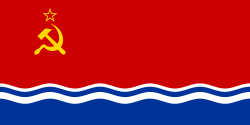
In 1944, when the Soviet military advances reached the area heavy fighting took place in Latvia between German and Soviet troops, which ended with another German defeat. Riga was re-captured by the Soviet Red Army on October 13, 1944, while the Courland Pocket held out until May 9, 1945. During the course of the war, both occupying forces conscripted Latvians into their armies, in this way increasing the loss of the nation's "live resources". In 1944, part of the Latvian territory once more came under Soviet control and Latvian national partisans began their fight against another occupier – the Soviet Union. 160,000 Latvian inhabitants took refuge from the Soviet army by fleeing to Germany and Sweden.On the other side, many Latvians who had previously supported Bolshevism had chosen to remain in Soviet Russia, where they wielded disproportionate influence in the party.[13]
Purge of national communists[szerkesztés]
On March 5, 1953 Joseph Stalin died and his successor became Nikita Khrushchev. The period known as the Khrushchev Thaw began but attempts by the national communists led by Eduards Berklavs to gain a degree of autonomy for the republic and protect the rapidly deteriorating position of the Latvian language were not successful. In 1959 after Krushchev's visit in Latvia national communists were stripped of their posts and Berklavs was deported to Russia.
Influx of Soviet immigrants[szerkesztés]
Because Latvia had still maintained a well-developed infrastructure and educated specialists it was decided in Moscow that some of the Soviet Union's most advanced manufacturing factories were to be based in Latvia. New industry was created in Latvia, including a major machinery factory RAF in Jelgava, electrotechnical factories in Riga, chemical factories in Daugavpils, Valmiera and Olaine, as well as food and oil processing plants.[37] However, there were not enough people to operate the newly built factories. In order to expand industrial production, more immigrants from other Soviet republics were transferred into the country, noticeably decreasing the proportion of ethnic Latvians.
By 1989, the ethnic Latvians comprised about 52% of the population (1,387,757), compared to a pre-war proportion of 77% (1,467,035). In 2005 there were 1,357,099 ethnic Latvians, showing a real decrease in the titular population. Proportionately, however, the titular nation already comprises approximately 60% of the total population of Latvia (2,375,000).[forrás?]
-
Portable radio built in RRR
-
Soviet stamp celebrating 40 years of Latvian SSR
-
Train built in RVR
-
The iconic RAF minibus
-
Monument to the Red Latvian Riflemen in Riga
-
The abandoned House of Press
-
Soviet nomenklatura sanatorium in Jūrmala
Restoration of independence[szerkesztés]

Liberalization in the communist regime began in the mid-1980s in the USSR with the perestroika and glasnost instituted by Mikhail Gorbachev. In Latvia, several mass political organizations were constituted that made use of this opportunity – Popular Front of Latvia (Tautas Fronte), Latvian National Independence Movement (Latvijas Nacionālās Neatkarības Kustība) and Citizens' Congress (Pilsoņu kongress). These groups began to agitate for the restoration of national independence.
On the 50th anniversary of the Molotov-Ribbentrop pact (August 23, 1989) to the fate of the Baltic nations, Latvians, Lithuanians and Estonians joined hands in a human chain, the Baltic Way, that stretched 600 kilometers from Tallinn, to Riga, to Vilnius. It symbolically represented the united wish of the Baltic States for independence.
Subsequent steps toward full independence were taken on May 4, 1990. The Latvian SSR Supreme Council, elected in the first democratic elections since the 1930s, adopted a declaration restoring independence that included a transition period between autonomy within the Soviet Union and full independence. In January 1991, however, pro-communist political forces attempted to restore Soviet power with the use of force. Latvian demonstrators managed to stop the Soviet troops from re-occupying strategic positions (January 1991 events in Latvia). On August 21, after the unsuccessful attempt at a coup d'état in Moscow, parliament voted for an end to the transition period, thus restoring Latvia's pre-war independence. On September 6, 1991, Latvian independence was once again recognized by the Soviet Union.
Modern history[szerkesztés]

Soon after reinstating independence, Latvia, which had been a member of the League of Nations prior to World War II, became a member of the United Nations. In 1992, Latvia became eligible for the International Monetary Fund and in 1994 took part in the NATO Partnership for Peace program in addition to signing the free trade agreement with the European Union. Latvia became a member of the European Council as well as a candidate for the membership in the European Union and NATO. Latvia was the first of the three Baltic nations to be accepted into the World Trade Organization.
At the end of 1999 in Helsinki, the heads of the European Union governments invited Latvia to begin negotiations regarding accession to the European Union. In 2004, Latvia's most important foreign policy goals, membership of the European Union and NATO, were fulfilled. On April 2, Latvia became a member of NATO [38] and on May 1, Latvia, along with the other two Baltic States, became a member of the European Union.[39] Around 67% had voted in favor of EU membership in a September 2003 referendum with turnout at 72.5%.[40] Latvia signed the Schengen agreement on 16 April 2003 and started its implementation on 21 December 2007.[41] In November 2013, roof collapsed at a shopping center in Riga, causing Latvia's worst post-independence disaster with the deaths of 54 rush hour shoppers and rescue personnel.[42] On 1 January 2014, Latvia joined the eurozone, becoming a member of the group of EU states which uses the euro as its currency.[43]
In May 2023, the parliament elected Edgars Rinkevics as new President of Latvia, making him the Baltic States’ first openly gay head of state.[44]
Regional timeline[szerkesztés]
Sablon:Unreferenced section Affiliations of the areas that comprise modern Latvia in historical and regional context:
| Century | ||||||
|---|---|---|---|---|---|---|
| North Estonia | South Estonia | North Latvia | South Latvia | Lithuania | ||
| 10th | Finnic tribes | Baltic tribes | Baltic tribes | |||
| 11th 12th | Ancient Estonia | Ancient Latvia | Ancient Lithuania | |||
| 13th | Danish Estonia | Livonian Order | Duchy of Lithuania | |||
| 14th | Polish–Lithuanian Commonwealth (Grand Duchy of Lithuania) | |||||
| 15th | ||||||
| 16th | Swedish Estonia | Polish–Lithuanian Commonwealth (Duchy of Livonia) | ||||
| 17th | Swedish Livonia | |||||
| 18th | Russian Empire (Governorate of Estonia) | Russian Empire (Governorate of Livonia) | Polish–Lithuanian Commonwealth (Duchy of Courland and Semigallia) | |||
| 19th | Russian Empire (Courland Governorate) | Russian Empire (Government of Kaunas) | Russian Empire (Vilna Governorate) | |||
| 20th | Republic of Estonia | Republic of Latvia | Republic of Lithuania | |||
| 21st | Republic of Estonia (EU) | Republic of Latvia (EU) | Republic of Lithuania (EU) | |||
See also[szerkesztés]
- Dissolution of the Soviet Union
- History of Riga
- Latvian independence movement (1940–1991)
- Latvian diplomatic service (1940–1991)
- List of presidents of Latvia
- Prime Minister of Latvia
- Livonia
- Politics of Latvia
Sablon:History Timeline of Latvia
Notes[szerkesztés]
- ↑ Soviet-Latvian negotiations started on October 2, 1939 and on the following day Latvia's Minister of Foreign Affairs Vilhelms Munters informed his government that Josif Stalin had said that "as for the Germans, [there is no obstacle], we can occupy you" and threatened that the USSR could also seize "territory with a Russian minority."[31]
- ↑ and presenting the ultimatum and accusations of violation by Latvia of the terms of mutual assistance treaty of 1939, Molotov issued an overt threat to "take action" to secure compliance with the terms of ultimatum – see report of Latvian Chargé d'affaires, Fricis Kociņš, regarding the talks with soviet Foreign Commissar Molotov.[32]
References[szerkesztés]
- ↑ 22.6 thousand Latvian residents chose to emigrate in 2013. [2018. május 23-i dátummal az eredetiből archiválva]. (Hozzáférés: 2016. március 25.)
- ↑ a b Ancient History of Latvia (11000 BC – 1200)
- ↑ Data: 3000 BC to 1500 BC – The Ethnohistory Project Archiválva 2006. június 22-i dátummal a Wayback Machine-ben.
- ↑ Vēlais dzelzs laikmets
- ↑ British Museum Collection. [2019. június 18-i dátummal az eredetiből archiválva]. (Hozzáférés: 2017. június 15.)
- ↑ Vane, Charles William. Recollections of a tour in the north of Europe in 1836–1837, 178. o. (1838)
- ↑ Brand, Hanno. Trade, diplomacy and cultural exchange: continuity and change in the North Sea area and the Baltic, c. 1350–1750. Uitgeverij Verloren, 17. o. (2005). ISBN 90-6550-881-3
- ↑ Plakans, Andrejs. A Concise History of the Baltic States. Cambridge University Press, 95. o. (2011). ISBN 978-0-521-54155-8
- ↑ Ragsdale, Hugh. Imperial Russian foreign policy. Cambridge University Press, 42. o. (1993). ISBN 978-0-521-44229-9
- ↑ a b Zemnieku brīvlaišana
- ↑ Māju iepirkšana
- ↑ Kenneth Scott Latourette, Christianity in a Revolutionary Age (1959) 2:199
- ↑ a b c d e f g Will Mawhood: What became of Latvia's left?. openDemocracy. [2019. március 2-i dátummal az eredetiből archiválva]. (Hozzáférés: 2017. december 18.)
- ↑ Bleiere, Daina. History of Latvia : the 20th century.. Riga: Jumava, 68. o. (2006). ISBN 9984-38-038-6. OCLC 70240317
- ↑ 1914. gads: mobilizācija un kaujas Austrumprūsijā
- ↑ a b c d e f Economic and Financial Development in Latvia (1920–1940)
- ↑ Laserson, Max. The Recognition of Latvia, The American Journal of International Law, Vol. 37, No. 2 (April 1943), pp. 233–247
- ↑ 1918.gada 18.novembris – ne tik pašsaprotams
- ↑ LtCol Andrew Parrott. „The Baltic States from 1914 to 1923: The First World War and the Wars of Independence”. Baltic Defence Review 2/2002.
- ↑ a b c Colonel Jaan Maide. Ülevaade Eesti Vabadussõjast (1918–1920) (Overview on Estonian War of Independence) (észt nyelven)
- ↑ Compare http://www.worldlii.org/int/other/LNTSer/1920/63.html
- ↑ 90 years since Latvia's international recognition. [2016. június 9-i dátummal az eredetiből archiválva]. (Hozzáférés: 2016. május 19.)
- ↑ Latvijas Republikas atzīšana de iure
- ↑ „Sveša negribam, bet sava arī nevienam nedosim” jeb Latvijas robežu vilkšana
- ↑ Latvijas un Lietuvas robežas izveidošanās
- ↑ Ēriks Jēkabsons. Latvijas un Polijas robeža 1919.-1939. gadā.
- ↑ Latvijas valsts ārpolitika un diplomātiskais dienests. [2016. június 1-i dátummal az eredetiből archiválva]. (Hozzáférés: 2016. május 1.)
- ↑ Politiskās partijas
- ↑ Tautas nobalsošanas Latvijā starpkaru periodā 20.gadsimta 20. – 30.gados. [2014. április 22-i dátummal az eredetiből archiválva]. (Hozzáférés: 2016. április 14.)
- ↑ Bleiere, Daina. History of Latvia: the 20th century. Riga: Jumava, 195. o. (2006). ISBN 9984-38-038-6. OCLC 70240317
- ↑ Dr. hab.hist. Inesis Feldmanis: The Occupation of Latvia: Aspects of History and International Law. Ministry of Foreign Affairs of Latvia, 2004. [2007. június 30-i dátummal az eredetiből archiválva]. (Hozzáférés: 2007. február 21.)
- ↑ I.Grava-Kreituse, I.Feldmanis, J.Goldmanis, A.Stranga.. Latvijas okupācija un aneksija 1939–1940: Dokumenti un materiāli. (The Occupation and Annexation of Latvia: 1939–1940. Documents and Materials.) (lett nyelven). Preses nams, 348–350. o. (1995)[halott link]
- ↑ see text of ultimatum; text in Latvian: I.Grava-Kreituse, I.Feldmanis, J.Goldmanis, A.Stranga.. Latvijas okupācija un aneksija 1939–1940: Dokumenti un materiāli. (The Occupation and Annexation of Latvia: 1939–1940. Documents and Materials.). Preses nams, 340–342. o. (1995)
- ↑ szerk.: Elmārs Pelkaus: Aizvestie: 1941. gada 14. jūnijā (lv, en, ru nyelven). Riga: Latvijas Valsts arhīvs; Nordik (2001). ISBN 9984-675-55-6. OCLC 52264782
- ↑ a b c Ezergailis, A. The Holocaust in Latvia, 1996
- ↑ Simon Wiesenthal Center Multimedia Learning Center Online. [2007. január 10-i dátummal az eredetiből archiválva]. (Hozzáférés: 2005. szeptember 12.)
- ↑ Bleiere, Daina. History of Latvia : the 20th century.. Riga: Jumava, 379. o. (2006). ISBN 9984-38-038-6. OCLC 70240317
- ↑ Latvia and NATO | Aizsardzības ministrija (angol nyelven). www.mod.gov.lv
- ↑ EU 2004 enlargement: a miracle of freedom (angol nyelven). www.eppgroup.eu
- ↑ „Latvians celebrate Yes to EU”, www.aljazeera.com (angol nyelvű)
- ↑ Schengen Area - The 27 Member Countries of the Schengen Zone (angol nyelven). SchengenVisaInfo.com
- ↑ „Riga mourns Maxima roof collapse victims”, www.baltictimes.com
- ↑ „Latvia becomes 18th state to join the eurozone”, BBC News, 2014. január 1.
- ↑ „Latvian parliament elects foreign minister as new president”, Impartial Reporter, 2023. május 31. (angol nyelvű)
Further reading[szerkesztés]
- Bilmanis, Alfreds. A History of Latvia (1970).
- Coulby, David. "Language and citizenship in Latvia, Lithuania and Estonia: Education and the brinks of warfare." European Journal of Intercultural Studies 8.2 (1997): 125–134. online
- Dreifelds, Juris. "Demographic trends in Latvia." Nationalities Papers 12.1 (1984): 49–84. online
- Eglitis, Daina Stukuls. Imagining the Nation: History, Modernity, and Revolution in Latvia (Post-Communist Cultural Studies) (2005).
- Hiden, John, and Patrick Salmon. The Baltic nations and Europe: Estonia, Latvia and Lithuania in the twentieth century (Routledge, 2014).
- Kalnins, Mara. Latvia: A short history (Oxford University Press, 2015).
- Lane, Thomas, et al. The Baltic States: Estonia, Latvia and Lithuania (Routledge, 2013) online.
- Lumans; Valdis O. Latvia in World War II (Fordham University Press, 2006)
- McDowell, Linda. "Cultural memory, gender and age: young Latvian women's narrative memories of war-time Europe, 1944–1947." Journal of Historical Geography 30.4 (2004): 701–728. online
- Minins, Aldis. "Latvia, 1918–1920: a civil war?." Journal of Baltic Studies 46.1 (2015): 49–63.
- O'Connor, Kevin. The History of the Baltic States (2nd ed. ABC-CLIO, 2015).
- Palmer, Alan. The Baltic: A new history of the region and its people New York: Overlook Press, 2006; published In London with the title Northern shores: a history of the Baltic Sea and its peoples (John Murray, 2006).
- Plakans, Andrejs. Historical Dictionary of Latvia (2008). online
- Plakans, Andrejs. The Latvians: A Short History (1995).
- Shafir, Gershon. Immigrants and nationalists: Ethnic conflict and accommodation in Catalonia, the Basque Country, Latvia, and Estonia (SUNY Press, 1995) online.
Primary sources[szerkesztés]
- Skultans, Vieda. The testimony of lives: Narrative and memory in post-Soviet Latvia (Routledge, 2002) [1].
External links[szerkesztés]
- National History Museum of Latvia
- History of Latvia Archiválva 2007. július 15-i dátummal a Wayback Machine-ben. The Route from the Vikings to the Greeks
- History of Latvia; A Brief Survey (en) Archiválva 2007. július 15-i dátummal a Wayback Machine-ben.
- History of Latvia: Primary Documents
- Issues of the History of Latvia: 1939–1991
- Castle ruins in Latvia
- Myths of Latvian History (en)
- Occupation of Latvia (PDF file 2.85MB) Archiválva 2008. szeptember 11-i dátummal a Wayback Machine-ben.
- Latvia: Year of horror (1940)
- The Story of Latvia, by Arveds Svabe
- Historical maps of Latvia in the 16th, 17th and 18th century
- Medieval Castles of Latvia
Sablon:Latvia topics Sablon:Years in Latvia Sablon:European history by country Sablon:History of Europe

A genetika vagy örökléstan az élőlények tulajdonságainak öröklődését, a tulajdonságokat kialakító géneket tanulmányozó tudományág. A biológia egyik alapvető ága, mivel az öröklődés ismerete létfontosságú az élőlények evolúciójának megértéséhez. Alapvető törvényszerűségeit Gregor Mendel brünni szerzetes ismerte fel először a 19. században; megfigyelte, hogy a szervezetek (borsónövények) tulajdonságaikat különálló "öröklődési egységek" (ma géneknek nevezzük) révén adják az utódaiknak.
A tulajdonságok öröklődése és a gének molekuláris öröklődési mechanizmusainak megértése továbbra is a genetika elsődleges feladatai, de a 20. század közepétől teendői kibővültek a gének működésének és viselkedésének tanulmányozásával. A tudományág számos részterületre bomlott, ide tartozik többek között a molekuláris genetika, az epigenetika vagy a populációgenetika. A genetika az élővilág valamennyi csoportját (beleértve az eukariótákt, prokariótákat, sőt a nem mindig élőnek tekintett vírusokat is) tanulmányozza.
A genetikai folyamatok az élőlény környezetével együttesen befolyásolják annak tulandonságait vagy viselkedését. A gének kifejeződését a sejten belüli vagy kívüli környezeti tényezők egyaránt növelhetik vagy visszafoghatják.
Története[szerkesztés]
A genetika szó az ógörög γενετικός (genetikosz, jelentése nemző, létrehozó) kifejezésből ered, amely a "származás" jelentésű γένεσις-ből (geneszisz) származtatott.[1][2][3]
Ősidők óta ismert, hogy az utódok öröklik szüleik tulajdonságait. A jelenséget a mezőgazdaságban az állatok és növények háziasítása, nemesítése során széleskörűen felhasználták.[4][5] A modern, tudományos alapokon nyugvó genetika a 19. század közepén, a morvaországi Gregor Mendel ágostonos szerzetes munkásságával kezdődött.[6]
Mendelt megelőzően a magyar Festetics Imre már felismerte az öröklődés egyes törvényszerűségeit és ő használta mai értelemben először a genetika kifejezést. 1819-ben közzétett, juhnemesítési tapasztalait összegző művében A természet genetikai törvényei-ben (Die genetischen Gesetze der Natur) ő is megfogalmazza Mendel második törvényét a nagyszülői tulajdonságok újra felbukkanásáról, valamint a mutációk megjelenéséről is számot ad.[7][8][9]

A 19. században úgy vélték, hogy a szülők tulajdonságai az utódban elkeverednek, átlagolódnak (Darwin is ezt a modellt követte A fajok eredeté-ben).[10] A gyakorlati tapasztalat valóban ezt mutatja számos esetben (pl. testmagasság, bőrszín, stb.), Mendel a munkájában azonban számos olyan példát mutatott, ahol a tulajdonságok egyáltalán nem keveredtek és a következő nemzedékekben teljes mivoltukban újra feltűntek. A látszólagos vegyülés csak a sokgénes tulajdonságoknál lép fel. A másik népszerű öröklődésmodell Jean-Baptiste Lamarck nevéhez fűződik; ő azt állította, hogy a szerzett tulajdonságok is öröklődhetnek, az izmos kovács gyerekei izmosabbak lesznek az átlagnál, a lombért nyújtózkodó zsiráf utódainak hosszabb lesz a nyaka. Elméletét August Weismann kísérletekkel cáfolta.[11] Darwin és követője, Francis Galton is kidolgozta a maga pangenetikus elméletét, miszerint a testrészek és szervek apró, gemmuláknak nevezett részecskéket bocsátanak ki, amelyek az ivarsejtekben koncentrálódnak és így kerülnek át a tulajdonságok a kö vetkező nemzedékbe.[12]
Mendeli genetika[szerkesztés]

A modern genetika Gregor Mendel munkájával kezdődött. 1865-ben "Növényhibridekkel végzett kísérletek" (Versuche über Pflanzenhybriden) címmel bemutatta a brünni Természettudományos Társaságnak (Naturforschender Verein) addigi kutatásainak összegzését. Mendel a borsó bizonyos tulajdonságainak öröklődését vizsgálta nemzedékeken keresztül és eredményeit matematikai módszerekkel is feldolgozta. Bár az általa felfedezett törvényszerűségek nem minden minden tulajdonság esetében voltak megfigyelhetők, de azt bebizonyította, hogy az tulajdonságok különálló "csomagokban" adódnak át és nem keverednek és átadódásuk egyszerű matematikai képletekkel leírható.[13]
A tudományos közvélemény nem ismerte fel azonnal Mendel eredményeinek jelentőségét, csak halála után ismerték el, amikor 1900-ban Hugo de Vries és más kutatók újrafelfedezték törvényeit. A genetika kifejezés is ekkor terjedt el, miután William Bateson 1905-ben javasolta használatát.[14][15]
A Mendel-törvények újrafelfedezését követően a kutatók azt próbálták kideríteni, hogy a sejt mely molekulái felelősek az öröklődését. Az amerikai Nettie Stevens 1905-ben felfedezte, hogy a lisztbogarak nőstényeinek csak X, míg a hímeknek X és Y kromoszómái vannak. Megállapította, hogy a nemet a kromoszómák határozzák meg és attól függ, hogy a hím milyen spermiuma termékenyíti meg a petesejtet.[16] 1911-ben Thomas Hunt Morgan kijelentette, hogy a gének a kromoszómákon kell hogy legyenek, ugyanis megfigyelte, hogy a muslicák fehérszem-mutációja nemhez kötött, azzal együtt öröklődik.[17] Tanítványa, Alfred Sturtevant 1913-ban a génkapcsoltság tanulmányozásával bebizonyította, hogy a gének sorban helyezkednek el a kromoszómán.[18]
Molekuláris genetika[szerkesztés]
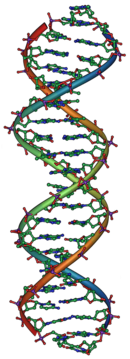
Bár azt már tudták, hogy a gének a kromoszómákon találhatóak, rejtély maradt hogy azok két komponense, a fehérjék és a nukleinsavak közül melyik felelős az öröklődésért. 1928-ban a brit Frederick Griffith felfedezte a transzformáció jelenségét: elpusztult baktériumokból genetikai anyagot átvive élőkre, az utóbbiak megkaptak az előbbiek tulajdonságait, átváltoztak ("transzformálódtak"). Tizenhat évvel később, 1944-ben Oswald Avery bebizonyította, hogy a transzformációt a DNS okozza.[19] 1943-ban Joachim Hämmerling egysejtű algakísérleteivel kimutatta, hogy az eukariótákban a genetikai anyag a sejtmagban található.[20] 1952 Alfred Hershey és Martha Chase bakteriofágokkal dolgozva megerősítette, hogy a vírusok esetében is a DNS (nem pedig a fehérje) az örökletes tulajdonságok hordozója.[21]
1953-ban James Watson és Francis Crick röntgenkrisztallográfiás felvételek segítségével meghatározta a DNS-molekula szerkezetét: kiderült, hogy az két, spirálisan egymás köré tekeredő, rendkívül hosszú szálból áll.[22][23] A polimerszálak alapegységei, a négyféle nukleotid befelé nézve, egymást kiegészítve kapcsolódtak, mint egyfajta megcsavart létra fokai.[24] A szerkezetből magától értetődően következett, hogy a genetikai információ a nukleotidok sorrendjében (szekvenciájában) rejlik. Egyúttal azt is megmagyarázta, hogy hogyan kettőződik meg a DNS a sejtosztódás során; a széttekeredő szálak saját maguk szolgáltak mintául (templátul) a kiegészítő szálnak. A leányDNS-ek egyik szála mindig a régi DNS-ből származik, míg a másik újonnan szintetizálódik (a DNS szemikonzervatív).[25]
Bár a DNS szerkezete magyarázta az öröklődés általános működését, továbbra is rejtély volt, hogy milyen módon befolyásolja a sejt működését. Az elkövetkező években a kutatás elsősorban arra irányult, hogy hogyan szabályozza a DNS a proteinek termelését.[26] Felfedezték, hogy a DNS egyik száláról RNS (ribonukleinsav, ami kémiailag nagyon hasonlít a DNS-re) másolat készül, az ún. hírvivő RNS (mRNS). Ennek nukleotidsorrendje a genetikai kódnak megfelelően fordítódik le a sejt citoplazmájában a fehérje aminosavszekvenciájára.[27]
Az öröklődés és sejtműködés alapelveinek tisztázása számtalan új felfedezés felé nyitotta meg az utat.[28] 1968-ban a japán Kimura Otó megfogalmazta a molekuláris evolúció semleges elméletét, miszerint az evolúció DNS-szinten a semleges (aminosavszekvenciában nem mutatkozó) mutációk felhalmozódásával is folyhat.[29] 1977-ben Frederick Sanger kifejlesztette a technikát a DNS nukleotidsorrendjének leolvasására (szekvenálására).[30] 1983-ban Kary Mullis felfedezett egy módszert, a polimeráz-láncreakciót a DNS egyes szakaszainak felszaporítására, lehetővé téve ezzel a specifikus részek gyors detektálását.[31] 2003-ra számos kutatócsoport nemzetközi együttműködésével (illetve velük párhuzamosan a Celera Genomics magáncég révén) sikeresen befejeződött a Human Genome Project, meghatározták az ember DNS-ének teljes bázissorrendjét.[32][33]
Features of inheritance[szerkesztés]
Discrete inheritance and Mendel's laws[szerkesztés]
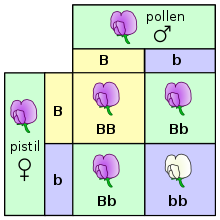
Egyszerűen megfogalmazva az öröklődés az élőlényekben úgy történik, hogy a szülőkről az utódokra különálló öröklési egységek, úgynevezett gének szállnak át.[34] Ezt a jelenséget először Gregor Mendel figyelte meg, aki borsónövényeken tanulmányozta az öröklődő tulajdonságok szétválását, és többek között kimutatta, hogy egy növény virágai vagy lilák vagy fehérek, de soha nem köztes színűek. Ugyanannak a génnek az adott megfigyelhető tulajdonságot (fenotípust) irányító különálló változatait alléloknak nevezzük.[13][35]
A borsó esetében (amely egy diploid faj) a növény minden egyes génből két példányt tartalmaz, véletlenszerűen egy-egy példányt örökölt mindkét szülőjétől.[36] Az állatok és növények többsége (köztük az ember is) hasonlóan működik. Ez a Mendel-törvények között a szétválás szabálya, az allélok egymástól elválva kerülnek az ivarsejtekbe. Azt az élőlényt, amely egy adott gén esetében ugyanazt az allélt örökölte mind a két szülőtől, homozigótának nevezzük (erre a génre vonatkoztatva), míg azokat amelyekben két különböző allél található, heterozigótának hívjuk. Az élőlény teljes génkészletének neve genotípus, míg a megfigyelhető tulajdonságaié fenotípus. A heterozigótáknál sok esetben csak az egyik allél hatása figyelhető meg a fenotípusban, a dominás allél elnyomja a recesszívet (a fenti példában a virág lilaságát meghatározó allél elnyomja a fehér szín allélját). Máskor a dominancia nem teljes és köztes fenotípus mutatkozik meg vagy kodomináns állapot lép fel, amikor mindkét allél egyformán kifejeződik.[37]
A domináns és recesszív allélok miatt azonban a fenotípus eltérhez a genotípustól. Mendel kísérleteiben kiderült, hogy a virágszínt vizsgálva az első nemzedék teljes egészében lila lett, míg ha ezeket egymás között tovább keresztezte, a második generáció növényeiben 3:1 arányban ismét megjelent a fehér szín.
Multiple gene interactions[szerkesztés]

Az élőlényeknek több ezer vagy tízezer génjük van, és az ivarosan szaporodó szervezetekben ezek a gének általában egymástól függetlenül rendeződnek; vagyis a borsószem sárga vagy zöld színét meghatározó allél öröklődése nincs kapcsolatban a fehér vagy lila virágok alléljának öröklődésével. Ezt a jelenséget Mendel második törvényének vagy a "független öröklődés törvényének" nevezik. Ennek hatására a gének alléljai az utódokban különféle kombinációkat hozhatnak létre. A gének sokszor egymással kölcsönhatva befolyásolják ugyanazt a tulajdonságot. A tavaszi békaszemnek (Omphalodes verna) például van egy génje, amelynek alléljai meghatározzák a virágok színét: kék vagy lila lehet. Egy másik gén viszont azt szabályozza, hogy a virágok egyáltalán színesek vagy inkább pigment nélküli fehérek legyenek. Ha egy növénynek két példánya van a fehér allélből, akkor a virágai fehérek lesznek, függetlenül attól, hogy az első gén kék vagy lila alléllal rendelkezik-e. Az efféle gének közötti kölcsönhatást episztázisnak nevezzük, a második gén episztatikusan hat az elsőre.[38]
Sok tulajdonság nem "bináris" jellegű (pl. vagy lila vagy fehér virág), hanem értéke folytonos skála mentén változik (ilyen pl. az ember magassága vagy bőrszíne). Ezeket általában sok gén befolyásolja egyszerre, ún. multigénes tulajdonságok.[39] A helyzetet tovább bonyolítja, hogy a végső tulajdonságra a környezet is jelentős hatást gyakorolhat (pl. gyerekkori éhezés a testmagasságra). Azt, hogy egy élőlény génjei mekkora mértékben járulnak hozzá egy tulajdonsághoz, heritabilitásnak nevezzük.[40] A heritabilitás értéke is különböző külső hatásoktól függhet, pl. a testmagasságnak az Egyesült Államokban 89%-os a heritabilitása, míg Nigériában (ahol a gyerekek élelmiszerhez és egészségügyi ellátáshoz való hozzáférése sokkal inkább függ a társadalmi helyzettől) mindössze 62%.[41]
Molecular basis for inheritance[szerkesztés]
DNA and chromosomes[szerkesztés]

A gének molekuláris szempontból a dezoxiribonukleinsavban (röviden DNS) testesülnek meg. A DNS egy hosszú lánc, amely egymással váltakozó dezoxiribóz (egyfajta cukormolekula) és foszfát molekuláiból áll és a cukorhoz oldalvást nitrogéntartalmú bázisok kapcsolódnak. Négy ilyen bázis létezik: az adenin (A), citozin (C), guanin (G) és a timin (T). A láncok oldalsó bázisai hidrogénkötésekkel egymáshoz kapcsolódnak (az adenin csak timinnel, a guanin csak citozinnal), hosszú kétszálú, létraszerű struktúrát hozva létre, amely spirálisan csavarodik: ez a híres kettős spirál.[42] A genetikai információ a bázisok sorrendjében (szekvenciájában) rejlik, a gének gyakorlatilag a hosszú DNS-lánc egyes szakaszainak felelnek meg.[43] A sejtben a rendkívül hosszú DNS-molekulák hisztonfehérjékre feltekeredve helyezkednek el, hogy kevesebb helyet foglaljanak. Az így felcsavart egyetlen DNS-molekula a kromoszóma.[44] Egyes vírusok DNS helyett a kémiailag igen hasonló ribonukleinsavat (RNS) használják genetikai információik tárolására.[45]
DNA normally exists as a double-stranded molecule, coiled into the shape of a double helix. Each nucleotide in DNA preferentially pairs with its partner nucleotide on the opposite strand: A pairs with T, and C pairs with G. Thus, in its two-stranded form, each strand effectively contains all necessary information, redundant with its partner strand. This structure of DNA is the physical basis for inheritance: DNA replication duplicates the genetic information by splitting the strands and using each strand as a template for synthesis of a new partner strand.[46]

Genes are arranged linearly along long chains of DNA base-pair sequences. In bacteria, each cell usually contains a single circular genophore, while eukaryotic organisms (such as plants and animals) have their DNA arranged in multiple linear chromosomes. These DNA strands are often extremely long; the largest human chromosome, for example, is about 247 million base pairs in length.[47] The DNA of a chromosome is associated with structural proteins that organize, compact, and control access to the DNA, forming a material called chromatin; in eukaryotes, chromatin is usually composed of nucleosomes, segments of DNA wound around cores of histone proteins.[48] The full set of hereditary material in an organism (usually the combined DNA sequences of all chromosomes) is called the genome.
DNA is most often found in the nucleus of cells, but Ruth Sager helped in the discovery of nonchromosomal genes found outside of the nucleus.[49] In plants, these are often found in the chloroplasts and in other organisms, in the mitochondria.[49] These nonchromosomal genes can still be passed on by either partner in sexual reproduction and they control a variety of hereditary characteristics that replicate and remain active throughout generations.[49]
While haploid organisms have only one copy of each chromosome, most animals and many plants are diploid, containing two of each chromosome and thus two copies of every gene. The two alleles for a gene are located on identical loci of the two homologous chromosomes, each allele inherited from a different parent.[36]
Many species have so-called sex chromosomes that determine the sex of each organism.[50] In humans and many other animals, the Y chromosome contains the gene that triggers the development of the specifically male characteristics. In evolution, this chromosome has lost most of its content and also most of its genes, while the X chromosome is similar to the other chromosomes and contains many genes. This being said, Mary Frances Lyon discovered that there is X-chromosome inactivation during reproduction to avoid passing on twice as many genes to the offspring.[51] Lyon's discovery led to the discovery of X-linked diseases.[51]
Reproduction[szerkesztés]

When cells divide, their full genome is copied and each daughter cell inherits one copy. This process, called mitosis, is the simplest form of reproduction and is the basis for asexual reproduction. Asexual reproduction can also occur in multicellular organisms, producing offspring that inherit their genome from a single parent. Offspring that are genetically identical to their parents are called clones.[52]
Eukaryotic organisms often use sexual reproduction to generate offspring that contain a mixture of genetic material inherited from two different parents. The process of sexual reproduction alternates between forms that contain single copies of the genome (haploid) and double copies (diploid).[36] Haploid cells fuse and combine genetic material to create a diploid cell with paired chromosomes. Diploid organisms form haploids by dividing, without replicating their DNA, to create daughter cells that randomly inherit one of each pair of chromosomes. Most animals and many plants are diploid for most of their lifespan, with the haploid form reduced to single cell gametes such as sperm or eggs.[53]
Although they do not use the haploid/diploid method of sexual reproduction, bacteria have many methods of acquiring new genetic information. Some bacteria can undergo conjugation, transferring a small circular piece of DNA to another bacterium.[54] Bacteria can also take up raw DNA fragments found in the environment and integrate them into their genomes, a phenomenon known as transformation.[55] These processes result in horizontal gene transfer, transmitting fragments of genetic information between organisms that would be otherwise unrelated. Natural bacterial transformation occurs in many bacterial species, and can be regarded as a sexual process for transferring DNA from one cell to another cell (usually of the same species).[56] Transformation requires the action of numerous bacterial gene products, and its primary adaptive function appears to be repair of DNA damages in the recipient cell.[56]
Recombination and genetic linkage[szerkesztés]

The diploid nature of chromosomes allows for genes on different chromosomes to assort independently or be separated from their homologous pair during sexual reproduction wherein haploid gametes are formed. In this way new combinations of genes can occur in the offspring of a mating pair. Genes on the same chromosome would theoretically never recombine. However, they do, via the cellular process of chromosomal crossover. During crossover, chromosomes exchange stretches of DNA, effectively shuffling the gene alleles between the chromosomes.[57] This process of chromosomal crossover generally occurs during meiosis, a series of cell divisions that creates haploid cells. Meiotic recombination, particularly in microbial eukaryotes, appears to serve the adaptive function of repair of DNA damages.[56]
The first cytological demonstration of crossing over was performed by Harriet Creighton and Barbara McClintock in 1931. Their research and experiments on corn provided cytological evidence for the genetic theory that linked genes on paired chromosomes do in fact exchange places from one homolog to the other.[58]
The probability of chromosomal crossover occurring between two given points on the chromosome is related to the distance between the points. For an arbitrarily long distance, the probability of crossover is high enough that the inheritance of the genes is effectively uncorrelated.[59] For genes that are closer together, however, the lower probability of crossover means that the genes demonstrate genetic linkage; alleles for the two genes tend to be inherited together. The amounts of linkage between a series of genes can be combined to form a linear linkage map that roughly describes the arrangement of the genes along the chromosome.[60]
Gene expression[szerkesztés]
Genetic code[szerkesztés]
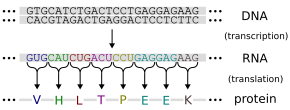
Genes express their functional effect through the production of proteins, which are molecules responsible for most functions in the cell. Proteins are made up of one or more polypeptide chains, each composed of a sequence of amino acids. The DNA sequence of a gene is used to produce a specific amino acid sequence. This process begins with the production of an RNA molecule with a sequence matching the gene's DNA sequence, a process called transcription.
This messenger RNA molecule then serves to produce a corresponding amino acid sequence through a process called translation. Each group of three nucleotides in the sequence, called a codon, corresponds either to one of the twenty possible amino acids in a protein or an instruction to end the amino acid sequence; this correspondence is called the genetic code.[61] The flow of information is unidirectional: information is transferred from nucleotide sequences into the amino acid sequence of proteins, but it never transfers from protein back into the sequence of DNA—a phenomenon Francis Crick called the central dogma of molecular biology.[62]
The specific sequence of amino acids results in a unique three-dimensional structure for that protein, and the three-dimensional structures of proteins are related to their functions.[63][64] Some are simple structural molecules, like the fibers formed by the protein collagen. Proteins can bind to other proteins and simple molecules, sometimes acting as enzymes by facilitating chemical reactions within the bound molecules (without changing the structure of the protein itself). Protein structure is dynamic; the protein hemoglobin bends into slightly different forms as it facilitates the capture, transport, and release of oxygen molecules within mammalian blood.[forrás?]
A single nucleotide difference within DNA can cause a change in the amino acid sequence of a protein. Because protein structures are the result of their amino acid sequences, some changes can dramatically change the properties of a protein by destabilizing the structure or changing the surface of the protein in a way that changes its interaction with other proteins and molecules. For example, sickle-cell anemia is a human genetic disease that results from a single base difference within the coding region for the β-globin section of hemoglobin, causing a single amino acid change that changes hemoglobin's physical properties.[65] Sickle-cell versions of hemoglobin stick to themselves, stacking to form fibers that distort the shape of red blood cells carrying the protein. These sickle-shaped cells no longer flow smoothly through blood vessels, having a tendency to clog or degrade, causing the medical problems associated with this disease.[forrás?]
Some DNA sequences are transcribed into RNA but are not translated into protein products—such RNA molecules are called non-coding RNA. In some cases, these products fold into structures which are involved in critical cell functions (e.g. ribosomal RNA and transfer RNA). RNA can also have regulatory effects through hybridization interactions with other RNA molecules (such as microRNA).[forrás?]
Nature and nurture[szerkesztés]
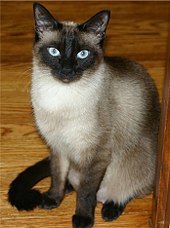
Although genes contain all the information an organism uses to function, the environment plays an important role in determining the ultimate phenotypes an organism displays. The phrase "nature and nurture" refers to this complementary relationship. The phenotype of an organism depends on the interaction of genes and the environment. An interesting example is the coat coloration of the Siamese cat. In this case, the body temperature of the cat plays the role of the environment. The cat's genes code for dark hair, thus the hair-producing cells in the cat make cellular proteins resulting in dark hair. But these dark hair-producing proteins are sensitive to temperature (i.e. have a mutation causing temperature-sensitivity) and denature in higher-temperature environments, failing to produce dark-hair pigment in areas where the cat has a higher body temperature. In a low-temperature environment, however, the protein's structure is stable and produces dark-hair pigment normally. The protein remains functional in areas of skin that are colder—such as its legs, ears, tail, and faceSablon:Emdashso the cat has dark hair at its extremities.[66]
Environment plays a major role in effects of the human genetic disease phenylketonuria. The mutation that causes phenylketonuria disrupts the ability of the body to break down the amino acid phenylalanine, causing a toxic build-up of an intermediate molecule that, in turn, causes severe symptoms of progressive intellectual disability and seizures. However, if someone with the phenylketonuria mutation follows a strict diet that avoids this amino acid, they remain normal and healthy.[67]
A common method for determining how genes and environment ("nature and nurture") contribute to a phenotype involves studying identical and fraternal twins, or other siblings of multiple births.[68] Identical siblings are genetically the same since they come from the same zygote. Meanwhile, fraternal twins are as genetically different from one another as normal siblings. By comparing how often a certain disorder occurs in a pair of identical twins to how often it occurs in a pair of fraternal twins, scientists can determine whether that disorder is caused by genetic or postnatal environmental factors. One famous example involved the study of the Genain quadruplets, who were identical quadruplets all diagnosed with schizophrenia.[69]
Gene regulation[szerkesztés]
The genome of a given organism contains thousands of genes, but not all these genes need to be active at any given moment. A gene is expressed when it is being transcribed into mRNA and there exist many cellular methods of controlling the expression of genes such that proteins are produced only when needed by the cell. Transcription factors are regulatory proteins that bind to DNA, either promoting or inhibiting the transcription of a gene.[70] Within the genome of Escherichia coli bacteria, for example, there exists a series of genes necessary for the synthesis of the amino acid tryptophan. However, when tryptophan is already available to the cell, these genes for tryptophan synthesis are no longer needed. The presence of tryptophan directly affects the activity of the genes—tryptophan molecules bind to the tryptophan repressor (a transcription factor), changing the repressor's structure such that the repressor binds to the genes. The tryptophan repressor blocks the transcription and expression of the genes, thereby creating negative feedback regulation of the tryptophan synthesis process.[71]
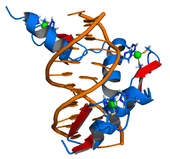
Differences in gene expression are especially clear within multicellular organisms, where cells all contain the same genome but have very different structures and behaviors due to the expression of different sets of genes. All the cells in a multicellular organism derive from a single cell, differentiating into variant cell types in response to external and intercellular signals and gradually establishing different patterns of gene expression to create different behaviors. As no single gene is responsible for the development of structures within multicellular organisms, these patterns arise from the complex interactions between many cells.[forrás?]
Within eukaryotes, there exist structural features of chromatin that influence the transcription of genes, often in the form of modifications to DNA and chromatin that are stably inherited by daughter cells.[72] These features are called "epigenetic" because they exist "on top" of the DNA sequence and retain inheritance from one cell generation to the next. Because of epigenetic features, different cell types grown within the same medium can retain very different properties. Although epigenetic features are generally dynamic over the course of development, some, like the phenomenon of paramutation, have multigenerational inheritance and exist as rare exceptions to the general rule of DNA as the basis for inheritance.[73]
Genetic change[szerkesztés]
Mutations[szerkesztés]

During the process of DNA replication, errors occasionally occur in the polymerization of the second strand. These errors, called mutations, can affect the phenotype of an organism, especially if they occur within the protein coding sequence of a gene. Error rates are usually very low—1 error in every 10–100 million bases—due to the "proofreading" ability of DNA polymerases.[74][75] Processes that increase the rate of changes in DNA are called mutagenic: mutagenic chemicals promote errors in DNA replication, often by interfering with the structure of base-pairing, while UV radiation induces mutations by causing damage to the DNA structure.[76] Chemical damage to DNA occurs naturally as well and cells use DNA repair mechanisms to repair mismatches and breaks. The repair does not, however, always restore the original sequence. A particularly important source of DNA damages appears to be reactive oxygen species[77] produced by cellular aerobic respiration, and these can lead to mutations.[78]
In organisms that use chromosomal crossover to exchange DNA and recombine genes, errors in alignment during meiosis can also cause mutations. Errors in crossover are especially likely when similar sequences cause partner chromosomes to adopt a mistaken alignment; this makes some regions in genomes more prone to mutating in this way. These errors create large structural changes in DNA sequence—duplications, inversions, deletions of entire regions—or the accidental exchange of whole parts of sequences between different chromosomes, chromosomal translocation.[79]

Natural selection and evolution[szerkesztés]
Mutations alter an organism's genotype and occasionally this causes different phenotypes to appear. Most mutations have little effect on an organism's phenotype, health, or reproductive fitness.[80] Mutations that do have an effect are usually detrimental, but occasionally some can be beneficial.[81] Studies in the fly Drosophila melanogaster suggest that if a mutation changes a protein produced by a gene, about 70 percent of these mutations are harmful with the remainder being either neutral or weakly beneficial.[82]

Population genetics studies the distribution of genetic differences within populations and how these distributions change over time.[83] Changes in the frequency of an allele in a population are mainly influenced by natural selection, where a given allele provides a selective or reproductive advantage to the organism,[84] as well as other factors such as mutation, genetic drift, genetic hitchhiking,[85] artificial selection and migration.[86]
Over many generations, the genomes of organisms can change significantly, resulting in evolution. In the process called adaptation, selection for beneficial mutations can cause a species to evolve into forms better able to survive in their environment.[87] New species are formed through the process of speciation, often caused by geographical separations that prevent populations from exchanging genes with each other.[88]
By comparing the homology between different species' genomes, it is possible to calculate the evolutionary distance between them and when they may have diverged. Genetic comparisons are generally considered a more accurate method of characterizing the relatedness between species than the comparison of phenotypic characteristics. The evolutionary distances between species can be used to form evolutionary trees; these trees represent the common descent and divergence of species over time, although they do not show the transfer of genetic material between unrelated species (known as horizontal gene transfer and most common in bacteria).[89]
Model organisms[szerkesztés]
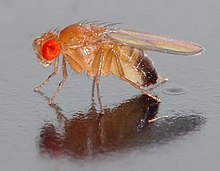
Although geneticists originally studied inheritance in a wide variety of organisms, the range of species studied has narrowed. One reason is that when significant research already exists for a given organism, new researchers are more likely to choose it for further study, and so eventually a few model organisms became the basis for most genetics research. Common research topics in model organism genetics include the study of gene regulation and the involvement of genes in development and cancer. Organisms were chosen, in part, for convenience—short generation times and easy genetic manipulation made some organisms popular genetics research tools. Widely used model organisms include the gut bacterium Escherichia coli, the plant Arabidopsis thaliana, baker's yeast (Saccharomyces cerevisiae), the nematode Caenorhabditis elegans, the common fruit fly (Drosophila melanogaster), the zebrafish (Danio rerio), and the common house mouse (Mus musculus).[90]
Medicine[szerkesztés]

Medical genetics seeks to understand how genetic variation relates to human health and disease.[91] When searching for an unknown gene that may be involved in a disease, researchers commonly use genetic linkage and genetic pedigree charts to find the location on the genome associated with the disease. At the population level, researchers take advantage of Mendelian randomization to look for locations in the genome that are associated with diseases, a method especially useful for multigenic traits not clearly defined by a single gene.[92] Once a candidate gene is found, further research is often done on the corresponding (or homologous) genes of model organisms. In addition to studying genetic diseases, the increased availability of genotyping methods has led to the field of pharmacogenetics: the study of how genotype can affect drug responses.[93]
Individuals differ in their inherited tendency to develop cancer, and cancer is a genetic disease. The process of cancer development in the body is a combination of events. Mutations occasionally occur within cells in the body as they divide. Although these mutations will not be inherited by any offspring, they can affect the behavior of cells, sometimes causing them to grow and divide more frequently. There are biological mechanisms that attempt to stop this process; signals are given to inappropriately dividing cells that should trigger cell death, but sometimes additional mutations occur that cause cells to ignore these messages. An internal process of natural selection occurs within the body and eventually mutations accumulate within cells to promote their own growth, creating a cancerous tumor that grows and invades various tissues of the body. Normally, a cell divides only in response to signals called growth factors and stops growing once in contact with surrounding cells and in response to growth-inhibitory signals. It usually then divides a limited number of times and dies, staying within the epithelium where it is unable to migrate to other organs. To become a cancer cell, a cell has to accumulate mutations in a number of genes (three to seven). A cancer cell can divide without growth factor and ignores inhibitory signals. Also, it is immortal and can grow indefinitely, even after it makes contact with neighboring cells. It may escape from the epithelium and ultimately from the primary tumor. Then, the escaped cell can cross the endothelium of a blood vessel and get transported by the bloodstream to colonize a new organ, forming deadly metastasis. Although there are some genetic predispositions in a small fraction of cancers, the major fraction is due to a set of new genetic mutations that originally appear and accumulate in one or a small number of cells that will divide to form the tumor and are not transmitted to the progeny (somatic mutations). The most frequent mutations are a loss of function of p53 protein, a tumor suppressor, or in the p53 pathway, and gain of function mutations in the Ras proteins, or in other oncogenes.[94][95]
Research methods[szerkesztés]
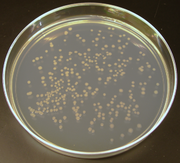
DNA can be manipulated in the laboratory. Restriction enzymes are commonly used enzymes that cut DNA at specific sequences, producing predictable fragments of DNA.[96] DNA fragments can be visualized through use of gel electrophoresis, which separates fragments according to their length.[forrás?]
The use of ligation enzymes allows DNA fragments to be connected. By binding ("ligating") fragments of DNA together from different sources, researchers can create recombinant DNA, the DNA often associated with genetically modified organisms. Recombinant DNA is commonly used in the context of plasmids: short circular DNA molecules with a few genes on them. In the process known as molecular cloning, researchers can amplify the DNA fragments by inserting plasmids into bacteria and then culturing them on plates of agar (to isolate clones of bacteria cells). "Cloning" can also refer to the various means of creating cloned ("clonal") organisms.[97]
DNA can also be amplified using a procedure called the polymerase chain reaction (PCR).[98] By using specific short sequences of DNA, PCR can isolate and exponentially amplify a targeted region of DNA. Because it can amplify from extremely small amounts of DNA, PCR is also often used to detect the presence of specific DNA sequences.[forrás?]
DNA sequencing and genomics[szerkesztés]
DNA sequencing, one of the most fundamental technologies developed to study genetics, allows researchers to determine the sequence of nucleotides in DNA fragments. The technique of chain-termination sequencing, developed in 1977 by a team led by Frederick Sanger, is still routinely used to sequence DNA fragments. Using this technology, researchers have been able to study the molecular sequences associated with many human diseases.[99]
As sequencing has become less expensive, researchers have sequenced the genomes of many organisms using a process called genome assembly, which uses computational tools to stitch together sequences from many different fragments.[100] These technologies were used to sequence the human genome in the Human Genome Project completed in 2003.[32] New high-throughput sequencing technologies are dramatically lowering the cost of DNA sequencing, with many researchers hoping to bring the cost of resequencing a human genome down to a thousand dollars.[101]
Next-generation sequencing (or high-throughput sequencing) came about due to the ever-increasing demand for low-cost sequencing. These sequencing technologies allow the production of potentially millions of sequences concurrently.[102][103] The large amount of sequence data available has created the subfield of genomics, research that uses computational tools to search for and analyze patterns in the full genomes of organisms. Genomics can also be considered a subfield of bioinformatics, which uses computational approaches to analyze large sets of biological data. A common problem to these fields of research is how to manage and share data that deals with human subject and personally identifiable information.[forrás?]
Society and culture[szerkesztés]
On 19 March 2015, a group of leading biologists urged a worldwide ban on clinical use of methods, particularly the use of CRISPR and zinc finger, to edit the human genome in a way that can be inherited.[104][105][106][107] In April 2015, Chinese researchers reported results of basic research to edit the DNA of non-viable human embryos using CRISPR.[108][109]
See also[szerkesztés]
- Bacterial genome size
- Cryoconservation of animal genetic resources
- Eugenics
- Embryology
- Genetic disorder
- Genetic diversity
- Genetic engineering
- Genetic enhancement
- Glossary of genetics (M−Z)
- Index of genetics articles
- Medical genetics
- Molecular tools for gene study
- Neuroepigenetics
- Outline of genetics
- Timeline of the history of genetics
- Plant genetic resources
References[szerkesztés]
- ↑ Genetikos (γενετ-ικός). Henry George Liddell, Robert Scott, A Greek-English Lexicon. Perseus Digital Library, Tufts University. [2010. június 15-i dátummal az eredetiből archiválva]. (Hozzáférés: 2012. február 20.)
- ↑ Genesis (γένεσις). Henry George Liddell, Robert Scott, A Greek-English Lexicon. Perseus Digital Library, Tufts University. [2010. június 15-i dátummal az eredetiből archiválva]. (Hozzáférés: 2012. február 20.)
- ↑ Sablon:Cite dictionary
- ↑ Science: The Definitive Visual Guide. Penguin, 362. o. (2009). ISBN 978-0-7566-6490-9
- ↑ (2022. július 1.) „Themes of Biological Inheritance in Early Nineteenth Century Sheep Breeding as Revealed by J. M. Ehrenfels”. Genes 13 (8), 1311. o. DOI:10.3390/genes13081311. PMID 35893050.
- ↑ (1991. július 1.) „Historical study: Johann Gregor Mendel 1822-1884”. American Journal of Medical Genetics 40 (1), 1–25; discussion 26. o. DOI:10.1002/ajmg.1320400103. PMID 1887835.
- ↑ Forráshivatkozás-hiba: Érvénytelen
<ref>címke; nincs megadva szöveg a(z)Poczai and Santiago-Blay 2021nevű lábjegyzeteknek - ↑ (2019. június 1.) „The emergence of genetics from Festetics' sheep through Mendel's peas to Bateson's chickens”. Journal of Genetics 98 (2), 63. o. DOI:10.1007/s12041-019-1108-z. PMID 31204695.
- ↑ (2014. január 1.) „Imre Festetics and the Sheep Breeders' Society of Moravia: Mendel's Forgotten "Research Network"”. PLOS Biology 12 (1), e1001772. o. DOI:10.1371/journal.pbio.1001772. PMID 24465180.
- ↑ Population Genetics. Georgetown University, 26. o. (2011). ISBN 978-1-4443-6245-9
- ↑ Lamarck, J-B (2008). Encyclopædia Britannica. Encyclopædia Britannica Online Archiválva 2020. április 14-i dátummal a Wayback Machine-ben. on 16 March 2008.
- ↑ Peter J. Bowler, The Mendelian Revolution: The Emergency of Hereditarian Concepts in Modern Science and Society (Baltimore: Johns Hopkins University Press, 1989): chapters 2 & 3.
- ↑ a b Mendel's Paper in English. [2016. január 13-i dátummal az eredetiből archiválva].
- ↑ genetics, n., Oxford English Dictionary, 3rd ed.
- ↑ Letter from William Bateson to Alan Sedgwick in 1905. The John Innes Centre. [2007. október 13-i dátummal az eredetiből archiválva]. (Hozzáférés: 2008. március 15.)
- ↑ Forráshivatkozás-hiba: Érvénytelen
<ref>címke; nincs megadva szöveg a(z)netnevű lábjegyzeteknek - ↑ (1983) „Thomas Hunt Morgan – The Geneticist”. Integrative and Comparative Biology 23 (4), 855–865. o. DOI:10.1093/icb/23.4.855.
- ↑ (1913) „The linear arrangement of six sex-linked factors in Drosophila, as shown by their mode of association”. Journal of Experimental Biology 14 (1), 43–59. o. DOI:10.1002/jez.1400140104.
- ↑ (1944. február 1.) „STUDIES ON THE CHEMICAL NATURE OF THE SUBSTANCE INDUCING TRANSFORMATION OF PNEUMOCOCCAL TYPES : INDUCTION OF TRANSFORMATION BY A DESOXYRIBONUCLEIC ACID FRACTION ISOLATED FROM PNEUMOCOCCUS TYPE III”. The Journal of Experimental Medicine 79 (2), 137–158. o. DOI:10.1084/jem.79.2.137. PMID 19871359.
- ↑ Cell and Molecular Biology. I.K. International Pvt Ltd, 221. o. (2008. április 24.). ISBN 978-81-89866-59-4
- ↑ (1952. május 1.) „Independent functions of viral protein and nucleic acid in growth of bacteriophage”. The Journal of General Physiology 36 (1), 39–56. o. DOI:10.1085/jgp.36.1.39. PMID 12981234.
- ↑ The Eighth Day of Creation: Makers of the Revolution in Biology. Cold Spring Harbor Laboratory Press, 51–169. o. (1979). ISBN 978-0-87969-477-7
- ↑ (1953. április 1.) „Molecular structure of nucleic acids; a structure for deoxyribose nucleic acid”. Nature 171 (4356), 737–738. o. DOI:10.1038/171737a0. PMID 13054692.
- ↑ (1953. május 1.) „Genetical implications of the structure of deoxyribonucleic acid”. Nature 171 (4361), 964–967. o. DOI:10.1038/171964b0. PMID 13063483.
- ↑ (2014. február 1.) „DNA replication at the single-molecule level”. Chemical Society Reviews 43 (4), 1201–1220. o. DOI:10.1039/c3cs60391a. PMID 24395040.
- ↑ Managing Science: Methodology and Organization of Research. Springer, 76. o. (2010). ISBN 978-1-4419-7488-4
- ↑ Encyclopedia of Evolution. Infobase Publishing, 134. o. (2009). ISBN 978-1-4381-1005-9
- ↑ Genetics and Reductionism. Cambridge University Press, 140. o. (1998). ISBN 978-0-521-63713-8
- ↑ Ohta T., Gillespie J.H. (1996). „Development of neutral and nearly neutral theories”. Theoretical Population Biology 49 (2), 128–142. o. DOI:10.1006/tpbi.1996.0007. PMID 8813019.
- ↑ (1977. december 1.) „DNA sequencing with chain-terminating inhibitors”. Proceedings of the National Academy of Sciences of the United States of America 74 (12), 5463–5467. o. DOI:10.1073/pnas.74.12.5463. PMID 271968.
- ↑ (1985. december 1.) „Enzymatic amplification of beta-globin genomic sequences and restriction site analysis for diagnosis of sickle cell anemia”. Science 230 (4732), 1350–1354. o. DOI:10.1126/science.2999980. PMID 2999980.
- ↑ a b Human Genome Project Information. Human Genome Project. [2008. március 15-i dátummal az eredetiből archiválva]. (Hozzáférés: 2008. március 15.)
- ↑ „The sequence of the human genome”. Science 291.
- ↑ Patterns of Inheritance: Introduction, An Introduction to Genetic Analysis, 7th, New York: W.H. Freeman (2000). ISBN 978-0-7167-3520-5
- ↑ Mendel's experiments, An Introduction to Genetic Analysis, 7th, New York: W.H. Freeman (2000). ISBN 978-0-7167-3520-5
- ↑ a b c Mendelian genetics in eukaryotic life cycles, An Introduction to Genetic Analysis, 7th, New York: W.H. Freeman (2000). ISBN 978-0-7167-3520-5
- ↑ Interactions between the alleles of one gene, An Introduction to Genetic Analysis, 7th, New York: W.H. Freeman (2000). ISBN 978-0-7167-3520-5
- ↑ Gene interaction and modified dihybrid ratios, An Introduction to Genetic Analysis, 7th, New York: W.H. Freeman (2000). ISBN 978-0-7167-3520-5
- ↑ (2005. június 1.) „Mapping the new frontier: complex genetic disorders”. The Journal of Clinical Investigation 115 (6), 1404–1407. o. DOI:10.1172/JCI25421. PMID 15931374.
- ↑ Quantifying heritability, An Introduction to Genetic Analysis, 7th, New York: W. H. Freeman (2000). ISBN 978-0-7167-3520-5
- ↑ (2001. július 1.) „Heritability of obesity-related traits among Nigerians, Jamaicans and US black people”. International Journal of Obesity and Related Metabolic Disorders 25 (7), 1034–1041. o. DOI:10.1038/sj.ijo.0801650. PMID 11443503.
- ↑ Campbell Biology. plus.pearson.com . (Hozzáférés: 2022. szeptember 28.)
- ↑ (2006. május 1.) „Genetics: what is a gene?”. Nature 441 (7092), 398–401. o. DOI:10.1038/441398a. PMID 16724031.
- ↑ Histone (angol nyelven). Genome.gov . (Hozzáférés: 2022. szeptember 28.)
- ↑ Microbiology, 3rd, Wm. C. Brown, 343. o. (1996). ISBN 0-697-21865-1
- ↑ Mechanism of DNA Replication, An Introduction to Genetic Analysis, 7th, New York: W.H. Freeman (2000). ISBN 978-0-7167-3520-5
- ↑ (2006. május 1.) „The DNA sequence and biological annotation of human chromosome 1”. Nature 441 (7091), 315–321. o. DOI:10.1038/nature04727. PMID 16710414.
- ↑ Alberts et al. (2002), II.4. DNA and chromosomes: Chromosomal DNA and Its Packaging in the Chromatin Fiber Archiválva 2007. október 18-i dátummal a Wayback Machine-ben.
- ↑ a b c Ruth Sager. Encyclopaedia Britannica . (Hozzáférés: 2020. június 8.)
- ↑ Sex chromosomes and sex-linked inheritance, An Introduction to Genetic Analysis, 7th, New York: W.H. Freeman (2000). ISBN 978-0-7167-3520-5
- ↑ a b (2015. február 1.) „Mary F. Lyon (1925-2014)”. Nature 518 (7537), 36. o, Kiadó: Springer Nature Limited. DOI:10.1038/518036a. PMID 25652989.
- ↑ clone. Merriam-Webster Dictionary . (Hozzáférés: 2023. november 13.)
- ↑ Haploid (angol nyelven). www.genome.gov . (Hozzáférés: 2024. február 10.)
- ↑ Bacterial conjugation, An Introduction to Genetic Analysis, 7th, New York: W.H. Freeman (2000). ISBN 978-0-7167-3520-5
- ↑ Bacterial transformation, An Introduction to Genetic Analysis, 7th, New York: W.H. Freeman (2000). ISBN 978-0-7167-3520-5
- ↑ a b c (2018. január 1.) „Sex in microbial pathogens”. Infection, Genetics and Evolution 57, 8–25. o. DOI:10.1016/j.meegid.2017.10.024. PMID 29111273.
- ↑ Nature of crossing-over, An Introduction to Genetic Analysis, 7th, New York: W. H. Freeman (2000). ISBN 978-0-7167-3520-5
- ↑ (1931. augusztus 1.) „A Correlation of Cytological and Genetical Crossing-Over in Zea Mays”. Proceedings of the National Academy of Sciences of the United States of America 17 (8), 492–497. o. DOI:10.1073/pnas.17.8.492. PMID 16587654.
- ↑ Crossover: Concepts and Applications in Genetics, Evolution, and Breeding. University of Wisconsin Press, 55. o. (1994). ISBN 978-0-299-13564-5
- ↑ Linkage maps, An Introduction to Genetic Analysis, 7th, New York: W. H. Freeman (2000). ISBN 978-0-7167-3520-5
- ↑ I. 5. DNA, RNA, and the Flow of Genetic Information: Amino Acids Are Encoded by Groups of Three Bases Starting from a Fixed Point, Biochemistry, 5th, New York: W.H. Freeman and Company (2002)
- ↑ (1970. augusztus 1.) „Central dogma of molecular biology”. Nature 227 (5258), 561–563. o. DOI:10.1038/227561a0. PMID 4913914.
- ↑ Alberts et al. (2002), I.3. Proteins: The Shape and Structure of Proteins Archiválva 2023. január 1-ji dátummal a Wayback Machine-ben.
- ↑ Alberts et al. (2002), I.3. Proteins: Protein Function Archiválva 2006. április 25-i dátummal a Wayback Machine-ben.
- ↑ How Does Sickle Cell Cause Disease?. Brigham and Women's Hospital: Information Center for Sickle Cell and Thalassemic Disorders, 2002. április 11. [2010. szeptember 23-i dátummal az eredetiből archiválva]. (Hozzáférés: 2007. július 23.)
- ↑ (2006. április 1.) „Albinism in the domestic cat (Felis catus) is associated with a tyrosinase (TYR) mutation”. Animal Genetics 37 (2), 175–178. o. DOI:10.1111/j.1365-2052.2005.01409.x. PMID 16573534.
- ↑ MedlinePlus: Phenylketonuria. NIH: National Library of Medicine. [2008. július 25-i dátummal az eredetiből archiválva]. (Hozzáférés: 2008. március 15.)
- ↑ For example, Nature via Nurture: Genes, Experience and What Makes Us Human. Fourth Estate, 73. o. (2003). ISBN 978-1-84115-745-0
- ↑ (1964) „The Genain Quadruplets: A Case Study and Theoretical Analysis of Heredity and Environment in Schizophrenia”. Behavioral Science 9 (4), 371. o. DOI:10.1002/bs.3830090407.
- ↑ (2002. február 1.) „Signal transduction and the control of gene expression”. Science 295 (5556), 813–818. o. DOI:10.1126/science.1066355. PMID 11823631.
- ↑ Alberts et al. (2002), II.3. Control of Gene Expression – The Tryptophan Repressor is a Simple Switch That Turns Genes On and Off in Bacteria Archiválva 2007. június 29-i dátummal a Wayback Machine-ben.
- ↑ (2003. március 1.) „Epigenetic regulation of gene expression: how the genome integrates intrinsic and environmental signals”. Nature Genetics 33 (Suppl), 245–254. o. DOI:10.1038/ng1089. PMID 12610534.
- ↑ (2007. február 1.) „Paramutation: from maize to mice”. Cell 128 (4), 641–645. o. DOI:10.1016/j.cell.2007.02.007. PMID 17320501.
- ↑ Spontaneous mutations, An Introduction to Genetic Analysis, 7th, New York: W.H. Freeman (2000). ISBN 978-0-7167-3520-5
- ↑ (2004. április 1.) „Lesion (in)tolerance reveals insights into DNA replication fidelity”. The EMBO Journal 23 (7), 1494–1505. o. DOI:10.1038/sj.emboj.7600158. PMID 15057282.
- ↑ Induced mutations, An Introduction to Genetic Analysis, 7th, New York: W. H. Freeman (2000). ISBN 978-0-7167-3520-5
- ↑ (2013. február 1.) „DNA base damage by reactive oxygen species, oxidizing agents, and UV radiation”. Cold Spring Harbor Perspectives in Biology 5 (2), a012559. o. DOI:10.1101/cshperspect.a012559. PMID 23378590.
- ↑ (2012. július 1.) „DNA damage by reactive species: Mechanisms, mutation and repair”. Journal of Biosciences 37 (3), 503–517. o. DOI:10.1007/s12038-012-9218-2. PMID 22750987.
- ↑ Chromosome Mutation I: Changes in Chromosome Structure: Introduction, An Introduction to Genetic Analysis, 7th, New York: W.H. Freeman (2000). ISBN 978-0-7167-3520-5
- ↑ Encyclopedia of Microbiology. Academic Press, 551. o. (2009). ISBN 978-0-12-373944-5
- ↑ Environmental Biology. Cambridge University Press, 118. o. (2009). ISBN 978-0-521-67982-4
- ↑ (2007. április 1.) „Prevalence of positive selection among nearly neutral amino acid replacements in Drosophila”. Proceedings of the National Academy of Sciences of the United States of America 104 (16), 6504–6510. o. DOI:10.1073/pnas.0701572104. PMID 17409186.
- ↑ Variation and its modulation, An Introduction to Genetic Analysis, 7th, New York: W.H. Freeman (2000). ISBN 978-0-7167-3520-5
- ↑ Selection, An Introduction to Genetic Analysis, 7th, New York: W. H. Freeman (2000). ISBN 978-0-7167-3520-5
- ↑ (2001. november 1.) „Is the population size of a species relevant to its evolution?”. Evolution; International Journal of Organic Evolution 55 (11), 2161–2169. o. DOI:10.1111/j.0014-3820.2001.tb00732.x. PMID 11794777.
- ↑ Random events, An Introduction to Genetic Analysis, 7th, New York: W.H. Freeman (2000). ISBN 978-0-7167-3520-5
- ↑ On the Origin of Species. John Murray, 1. o. (1859). ISBN 978-0-8014-1319-3
Earlier related ideas were acknowledged in On the Origin of Species, 3rd, John Murray, xiii. o. (1861). ISBN 978-0-8014-1319-3 - ↑ (2003. október 1.) „Perspective: models of speciation: what have we learned in 40 years?”. Evolution; International Journal of Organic Evolution 57 (10), 2197–2215. o. DOI:10.1554/02-727. PMID 14628909.
- ↑ (2002. szeptember 1.) „Genome trees and the tree of life”. Trends in Genetics 18 (9), 472–479. o. DOI:10.1016/S0168-9525(02)02744-0. PMID 12175808.
- ↑ The Use of Model Organisms in Instruction. University of Wisconsin: Wisconsin Outreach Research Modules. [2008. március 13-i dátummal az eredetiből archiválva]. (Hozzáférés: 2008. március 15.)
- ↑ NCBI: Genes and Disease. NIH: National Center for Biotechnology Information. [2007. február 20-i dátummal az eredetiből archiválva]. (Hozzáférés: 2008. március 15.)
- ↑ (2003. február 1.) „'Mendelian randomization': can genetic epidemiology contribute to understanding environmental determinants of disease?”. International Journal of Epidemiology 32 (1), 1–22. o. DOI:10.1093/ije/dyg070. PMID 12689998.
- ↑ Pharmacogenetics Fact Sheet. NIH: National Institute of General Medical Sciences. [2008. május 12-i dátummal az eredetiből archiválva]. (Hozzáférés: 2008. március 15.)
- ↑ (2004. október 1.) „Genetic predisposition to cancer - insights from population genetics”. Nature Reviews. Genetics 5 (10), 764–772. o. DOI:10.1038/nrg1450. PMID 15510167.
- ↑ Human Molecular Genetics 2, second, John Wiley & Sons Inc. (1999) Chapter 18: Cancer Genetics Archiválva 2005. szeptember 26-i dátummal a Wayback Machine-ben.
- ↑ Lodish et al. (2000), Chapter 7: 7.1. DNA Cloning with Plasmid Vectors Archiválva 2009. május 27-i dátummal a Wayback Machine-ben.
- ↑ (2015. július 1.) „Artificial cloning of domestic animals”. Proceedings of the National Academy of Sciences of the United States of America 112 (29), 8874–8878. o. DOI:10.1073/pnas.1501718112. PMID 26195770.
- ↑ Lodish et al. (2000), Chapter 7: 7.7. Polymerase Chain Reaction: An Alternative to Cloning
- ↑ Section 2, Chapter 6: 6.1. The Methodology for DNA Sequencing, Genomes 2, 2nd, Oxford: Bios (2002). ISBN 978-1-85996-228-2
- ↑ Brown (2002), Section 2, Chapter 6: 6.2. Assembly of a Contiguous DNA Sequence Archiválva 2007. február 8-i dátummal a Wayback Machine-ben.
- ↑ (2006. március 1.) „Gene sequencing. The race for the $1000 genome”. Science 311 (5767), 1544–1546. o. DOI:10.1126/science.311.5767.1544. PMID 16543431.
- ↑ (2007. május 1.) „Advanced sequencing technologies and their wider impact in microbiology”. The Journal of Experimental Biology 210 (Pt 9), 1518–1525. o. DOI:10.1242/jeb.001370. PMID 17449817.
- ↑ (2006. január 1.) „Genomes for all”. Scientific American 294 (1), 46–54. o. DOI:10.1038/scientificamerican0106-46. PMID 16468433. Sablon:Subscription required
- ↑ „Scientists Seek Ban on Method of Editing the Human Genome”, The New York Times, 2015. március 19.. [2015. március 19-i dátummal az eredetiből archiválva] (Hozzáférés: 2015. március 20.)
- ↑ „A Powerful New Way to Edit DNA”, The New York Times, 2015. március 3.. [2015. március 26-i dátummal az eredetiből archiválva] (Hozzáférés: 2015. március 20.)
- ↑ (2015. április 1.) „Biotechnology. A prudent path forward for genomic engineering and germline gene modification”. Science 348 (6230), 36–38. o. DOI:10.1126/science.aab1028. PMID 25791083.
- ↑ (2015. március 1.) „Don't edit the human germ line”. Nature 519 (7544), 410–411. o. DOI:10.1038/519410a. PMID 25810189.
- ↑ „Chinese Scientists Edit Genes of Human Embryos, Raising Concerns”, The New York Times, 2015. április 23.. [2015. április 24-i dátummal az eredetiből archiválva] (Hozzáférés: 2015. április 24.)
- ↑ (2015. május 1.) „CRISPR/Cas9-mediated gene editing in human tripronuclear zygotes”. Protein & Cell 6 (5), 363–372. o. DOI:10.1007/s13238-015-0153-5. PMID 25894090.
Further reading[szerkesztés]
- Essential Cell Biology, 4th Edition. Garland Science (2013). ISBN 978-1-317-80627-1
- An Introduction to Genetic Analysis, 7th, New York: W. H. Freeman (2000). ISBN 978-0-7167-3520-5
- Genetics: Analysis of Genes and Genomes, 6th, Jones & Bartlett (2005). ISBN 978-0-7637-1511-3
- A Dictionary of Genetics, 8th, New York: Oxford University Press (2013). ISBN 978-0-19-976644-4
- Molecular Cell Biology, 4th, New York: Scientific American Books (2000). ISBN 978-0-7167-3136-8
External links[szerkesztés]
- Sablon:Wikiquote-inline
- Sablon:Wikibooks-inline
- Sablon:Library resources about
- Sablon:In Our Time
- Sablon:Curlie
Sablon:Genetics Sablon:Chromosome genetics Sablon:Branches of biology Sablon:Biology nav




